Astrophysics, PHD
On this page:.

At a Glance: program details
- Location: Tempe campus
- Second Language Requirement: No
Program Description
Degree Awarded: PHD Astrophysics
The PhD program in astrophysics develops creative scholarship in students and prepares them for professional careers in astrophysics, astronomy or related fields.
Students in this program take graduate-level courses in stars and interstellar media, galaxies and cosmology; obtain quantitative skills through analysis and modelling; may have observing opportunities through regional and international telescope observatories; and conduct independent, fundamental astrophysical research. Graduate students work closely with a research advisor on a wide range of topics including theoretical physics, cosmology, galaxy dynamics, stellar evolution, exoplanets, and the development and building of instrumentation.
Graduate students in astrophysics become leaders in observational and theoretical research. They participate in NASA- and NSF-funded space missions and study topics such as how stars are born and die, how galaxies interact and evolve, and how the universe changed as it developed from its earliest beginnings.
The program's world-class faculty have research expertise across the full breadth of astrophysics including the solar system, stars and galaxies from the Milky Way and the most distant galaxies in the universe. Current ASU research applies both computational and observational approaches to the exploration of a range of topics such as fundamental cosmology and whether there is life on exoplanets.
Degree Requirements
84 credit hours, a written comprehensive exam, an oral comprehensive exam, a prospectus and a dissertation
Required Core (1 credit hour) SES 502 Exploring SESE Research (1)
Electives or Research (53 credit hours)
Other Requirements: Astrophysics Sequence (9 credit hours) AST 521 Stars and Interstellar Medium I (3) AST 522 Stars and Interstellar Medium II (3) AST 591 Seminar: Astrophysics (2) SES 501 SESE Colloquium (1)
Other Requirements: Galaxies and Cosmology Sequence, pick one (3 credit hours) AST 531 Galaxies and Cosmology I (3) AST 532 Galaxies and Cosmology II (3) AST 533 Galaxies and Cosmology III (3)
Other Requirements: Exoplanets and Planetary Science Sequence, pick one (3 credit hours) AST 598 Topic: Origins of Solar Systems (3) AST 598 Topic: Exploring Exoplanets (3) SES 598 Topic: Water in the Solar System (3)
Other Requirements: Instrumentation and Techniques Sequence, pick one (3 credit hours) AST 552 Astronomical Instrumentation and Data Analysis (3) SES 598 Topic: An Introduction to Astro-statistics (3) SES 598 Topic: Spectroscopy for Astrophysics (3) SES 598 Topic: Introductory Radio Astronomy (3)
Culminating Experience (12 credit hours) SES 799 Dissertation (12)
Additional Curriculum Information When approved by the student's supervisory committee and the Graduate College, this program allows 30 credit hours from a previously awarded master's degree in a related field to be used for this degree.
Substitutions for Other Requirement courses may be made per department approval.
Admission Requirements
Applicants must fulfill the requirements of both the Graduate College and The College of Liberal Arts and Sciences.
Applicants are eligible to apply to the program if they have earned a bachelor's or master's degree in any field from a regionally accredited institution.
Applicants must have a minimum cumulative GPA of 3.00 (scale is 4.00 = "A") in the last 60 hours of their first bachelor's degree program, or they must have a minimum cumulative GPA of 3.00 (scale is 4.00 = "A") in an applicable master's degree program.
All applicants must submit:
- graduate admissions application and application fee
- official transcripts
- statement of purpose
- three letters of recommendation
- proof of English proficiency
Additional Application Information An applicant whose native language is not English must provide proof of English proficiency regardless of their current residency.
Next Steps to attend ASU
Learn about our programs, apply to a program, visit our campus, application deadlines, career opportunities.
Professionals with expertise in astrophysics are in high demand across all sectors and industries, including remote sensing, data science, instrument building, computational science, defense industries and scientific research. Coding and numerical modeling skills translate across many domains, even beyond astrophysics. Skills in the measurement and analysis of data related to the physics, chemistry and structure of the universe and exoplanetary systems are valuable to businesses and institutions relying on data-driven strategies to explore beyond the Earth and solar system.
A doctoral degree in astrophysics is required for some careers in post-secondary education and research.
Career examples include:
- astrophysics professor
- data scientist
- instrument builder
- project manager
- research astronomer
- telescope operator
Program Contact Information
If you have questions related to admission, please click here to request information and an admission specialist will reach out to you directly. For questions regarding faculty or courses, please use the contact information below.
- [email protected]
- 480/965-5081
- Theoretical Astrophysics
- TA Internal Page
The Center for Astrophysics | Harvard & Smithsonian Theoretical Astrophysics (TA) division uses theoretical models and computer simulations to understand a variety of fundamental astrophysical phenomena.
Advances in astrophysics come through the interplay of observational discoveries and theoretical interpretations. The Theoretical Astrophysics (TA) Division at the Center for Astrophysics conducts field-leading research through the synthesis of expertise in theoretical and computational modeling with empirical data from the Center for Astrophysics’ observational and experimental divisions. The TA Division is composed of Harvard Astronomy Faculty, Smithsonian Astrophysical Observatory Scientists, and extensive cohorts of postdoctoral researchers, graduate, and undergraduate students. The TA division pursues excellence through the diversity of ideas and individuals involved in our research agendas. TA researchers are considering questions spanning the breadth of topics in astrophysics from cosmic inflation in the early universe to the possible biomes of exoplanets. The Institute for Theory and Computation (ITC) resides within the TA Division and leads efforts to integrate conceptual theory and computational modeling. The ITC unites Center for Astrophysics researchers around current topics in theoretical astrophysics with a vibrant intellectual life of seminars, group meetings, and colloquia . Additionally, the ITC offers Prize Postdoctoral Fellowships to exceptional candidates working in any field related to theoretical and/or numerical astrophysics. If you are interested in applying, please visit our application page for more information.
The research agenda and personnel of the TA division enjoy extensive overlap with Harvard’s multi-disciplinary Black Hole Initiative (BHI), as well as Harvard’s Departments of Earth and Planetary Sciences , and Statistics.
Computational resources in TA include its cluster, consisting of 24 nodes each with two water cooled Intel 24-core Platinum 8268 Cascade Lake processors with 4 GB of RAM per core, for a total of 192 GB of RAM per node. This gives a total of 1152 cores available for use and 4.6 TB of RAM. The nodes are interconnected with HDR Infiniband and is part of the larger Cannon Infiniband network .
- Life in the Universe
- Black Holes
- Neutron Stars and White Dwarfs
- Cosmic Microwave Background
- Dark Energy and Dark Matter
- Early Universe
- Variable Stars and Binaries
- Gravitational Lensing
- Starburst Galaxies
- Galaxy Formation and Evolution
- The Energetic Universe
- Planetary Systems
- The Milky Way Galaxy
- Extragalactic Astronomy
- Computational Astrophysics
- Einstein's Theory of Gravitation
- T.J. Martin
Related News
Unveiling black hole spins using polarized radio glasses, stellar surf's up: monster waves as tall as three suns are crashing upon a colossal star, billions of celestial objects revealed in gargantuan survey of the milky way, astrophysicists hunt for second-closest supermassive black hole, the most precise accounting yet of dark energy and dark matter, ready for its close-up: new technology sharpens images of black holes, new study sheds light on why stellar populations are so similar in milky way, star formation models including jets, radiation, winds, and supernovae, 'the dawn of a new era in astronomy', astronomers reveal first image of the black hole at the heart of our galaxy, abacussummit.
Department of Astronomy and Astrophysics
Phd program in astronomy and astrophysics.
Our faculty have been at the forefront of astronomy for over a century, shaping its course since the founding of our department by George Ellery Hale in 1892. Hale pioneered the big glass in telescopes that ushered in a new age in astronomy; Subrahmanyan Chandrasekhar defined the agenda of theoretical astrophysics for fifty years; Eugene Parker revolutionized our view of the sun and the role of magnetic fields in the cosmos; and David Schramm brought together particle physics and cosmology. Our students have been just as influential. Edwin Hubble solved the puzzle of the nebulae and discovered the expansion of the Universe; Nancy Grace Roman made the Hubble Space Telescope a reality; Carl Sagan advanced our understanding of the solar system and how to share the excitement of what we do with the public; and Jeremiah P. Ostriker’s manifold contributions have made him the leading theorist of his generation.
Today graduate students in the Department of Astronomy and Astrophysics have multiple opportunities to engage with our pre-eminent faculty and their research groups on short- or long-term projects to complete pre-candidacy requirements and doctoral theses. Research fields span a wide range, with close integration between theory and experiment, and are enhanced by our connections to the Enrico Fermi Institute , the Departments of Physics and the Geophysical Sciences , and the Kavli Institute for Cosmological Physics at the University of Chicago. We have strong partnerships with premiere facilities including Argonne National Laboratory and Fermilab , and we are a founding member of the 25-meter Giant Magellan Telescope , the world's largest optical telescope now under construction in the Chilean Andes.
The PhD in Astrophysics is a year-round, full-time doctoral program on the academic quarter system, which encourages students to explore a range of courses, engage with more faculty, and challenge themselves in a fast-paced and academically rigorous environment.
Summary of Requirements
- full-time scholastic residence of at least 300 units of coursework per quarter, including summer
- completion of required core graduate courses
- completion of one to three pre-candidacy research projects
- successful completion of a two-part candidacy exam
- completion of the teaching practicum
- identification of a thesis advisor
- formation of a thesis committee
- thesis research and preparation
- final examination
Each admitted student is assigned a mentor who will help the student navigate graduate school by guiding them to achieve academic and professional goals and supporting their well-being and personal development. The mentor can guide students in course selection, assist in navigating difficult situations when they arise, provide coaching when preparing for oral exams, and counsel regarding postdoc placement or other career options.
Financial Support
Graduate students in the Department of Astronomy and Astrophysics receive full financial support from a combination of University and departmental fellowships, teaching assistantships, and research assistantships. Students are also encouraged to seek out external fellowships, as these provide students with both financial support and the flexibility to focus on research goals of individual interest. A two-quarter practicum as a teaching assistant is required of all graduate students, typically in the first year of study. Teaching assignments include instructing lab sections for non-science majors, and collaborative teaching with the faculty instructor of lecture courses in the Major in Astrophysics program.
Students with questions may contact
- Fausto Cattaneo (Deputy Chair for Academic Affairs),
- Laticia Rebeles (Graduate Student Affairs Administrator),
- Bahareh Lampert (Dean of Students in the Physical Sciences Division),
- Amanda Young (Associate Director, Graduate Student Affairs) in UChicagoGRAD.
Department of Astronomy & Astrophysics
A virtual tour of the University of Chicago Department of Astronomy and Astrophysics
Related Links
- Online Application
- Information for International Students
- Graduate Course Catalog
- For Current Students
- Utility Menu
Apply | Contact Us | Carol Davis Fund Anonymous Feedback to the Physics Chair
Graduate studies, commencement 2019.
The Harvard Department of Physics offers students innovative educational and research opportunities with renowned faculty in state-of-the-art facilities, exploring fundamental problems involving physics at all scales. Our primary areas of experimental and theoretical research are atomic and molecular physics, astrophysics and cosmology, biophysics, chemical physics, computational physics, condensed-matter physics, materials science, mathematical physics, particle physics, quantum optics, quantum field theory, quantum information, string theory, and relativity.
Our talented and hardworking students participate in exciting discoveries and cutting-edge inventions such as the ATLAS experiment, which discovered the Higgs boson; building the first 51-cubit quantum computer; measuring entanglement entropy; discovering new phases of matter; and peering into the ‘soft hair’ of black holes.
Our students come from all over the world and from varied educational backgrounds. We are committed to fostering an inclusive environment and attracting the widest possible range of talents.
We have a flexible and highly responsive advising structure for our PhD students that shepherds them through every stage of their education, providing assistance and counseling along the way, helping resolve problems and academic impasses, and making sure that everyone has the most enriching experience possible.The graduate advising team also sponsors alumni talks, panels, and advice sessions to help students along their academic and career paths in physics and beyond, such as “Getting Started in Research,” “Applying to Fellowships,” “Preparing for Qualifying Exams,” “Securing a Post-Doc Position,” and other career events (both academic and industry-related).
We offer many resources, services, and on-site facilities to the physics community, including our electronic instrument design lab and our fabrication machine shop. Our historic Jefferson Laboratory, the first physics laboratory of its kind in the nation and the heart of the physics department, has been redesigned and renovated to facilitate study and collaboration among our students.
Members of the Harvard Physics community participate in initiatives that bring together scientists from institutions across the world and from different fields of inquiry. For example, the Harvard-MIT Center for Ultracold Atoms unites a community of scientists from both institutions to pursue research in the new fields opened up by the creation of ultracold atoms and quantum gases. The Center for Integrated Quantum Materials , a collaboration between Harvard University, Howard University, MIT, and the Museum of Science, Boston, is dedicated to the study of extraordinary new quantum materials that hold promise for transforming signal processing and computation. The Harvard Materials Science and Engineering Center is home to an interdisciplinary group of physicists, chemists, and researchers from the School of Engineering and Applied Sciences working on fundamental questions in materials science and applications such as soft robotics and 3D printing. The Black Hole Initiative , the first center worldwide to focus on the study of black holes, is an interdisciplinary collaboration between principal investigators from the fields of astronomy, physics, mathematics, and philosophy. The quantitative biology initiative https://quantbio.harvard.edu/ aims to bring together physicists, biologists, engineers, and applied mathematicians to understand life itself. And, most recently, the new program in Quantum Science and Engineering (QSE) , which lies at the interface of physics, chemistry, and engineering, will admit its first cohort of PhD students in Fall 2022.
We support and encourage interdisciplinary research and simultaneous applications to two departments is permissible. Prospective students may thus wish to apply to the following departments and programs in addition to Physics:
- Department of Astronomy
- Department of Chemistry
- Department of Mathematics
- John A. Paulson School of Engineering and Applied Sciences (SEAS)
- Biophysics Program
- Molecules, Cells and Organisms Program (MCO)
If you are a prospective graduate student and have questions for us, or if you’re interested in visiting our department, please contact [email protected] .
- GRADUATE STUDIES
- Admissions & Financial Aid
- Admissions FAQs
- Advising Team
- Advising Portal (Graduate)
- Course Requirements
- Other PhD Tracks
- Griffin Graduate School of Arts and Sciences
- GSAS Student Council
- PhD Thesis Help
- Tax Information

Astrophysics PhD
The Department of Astronomy offers a graduate program aimed at the PhD degree in astrophysics. Entering students need not have majored in astronomy, although some background in astronomy is desirable. A strong background in physics, however, is essential.
Research is a major part of the PhD program, and the department offers opportunities in a wide variety of fields, including theoretical and observational astrophysics; infrared, optical, and radio astronomy; time-domain astronomy; high-energy astrophysics and cosmology; discovery and analysis of exoplanets; star formation and stellar evolution.
The department has established six years as the normative time to degree. Normative time is the elapsed calendar time in years that under normal circumstances will be needed to complete all requirements for the PhD, assuming a student who enters without deficiencies, who is engaged in full-time uninterrupted study, and who is making desirable progress toward the degree.
Contact Info
[email protected]
501 Campbell Hall #3411
Berkeley, CA 94720
At a Glance
Department(s)
Admit Term(s)
Application Deadline
December 4, 2023
Degree Type(s)
Doctoral / PhD
Degree Awarded
GRE Requirements
William H. Miller III Department of Physics & Astronomy
- A&S Magazine
Explore JHU
Inside the krieger school.
- Departments, Programs, and Centers
- Faculty Directory
- Fields of Study
- Majors & Minors
Student & Faculty Resources
- Academic Catalog
- Faculty Handbook
- Registrar's Office
- University Policies & Document Library
Across Campus
- Admissions & Aid
- Johns Hopkins University Website
- Maps & Directions
You are here:
Graduate programs in physics and astronomy at Johns Hopkins University are among the top programs in the field. Students engage in original research starting in their first semester and have flexibility in choosing their course of research and designing their path through the program. A wide range of research projects—both theoretical and experimental—are available in astrophysics , condensed matter physics , and particle physics . Graduate students can work toward a PhD in either physics or astronomy and astrophysics. Our doctoral students are prepared for careers in physics and astronomy research, teaching, or in applications such as biophysics, space physics, and industrial research.
Graduate students at Johns Hopkins study and work in close collaboration with a world-renowned, award-winning physics and astronomy faculty , whose research is truly global. Students have access to state-of-the-art laboratories, and they are full participants in the vibrant intellectual life of the department. Research leading to the dissertation can be carried out not only within the Department of Physics and Astronomy, but also in collaboration with other research centers. Recent dissertation research has been conducted with members of the Johns Hopkins Applied Physics Laboratory , Space Telescope Science Institute , and the Goddard Space Flight Center .
Graduate students are involved in research projects beginning in their first semester at JHU. Students are free to explore different areas of research by working on short research projects with different advisers. A series of seminars, presentations and orientation events held in the fall semester help introduce students to the faculty in the department so that they can choose their first project. Such projects may last a semester or a year; they might become the prelude to their thesis work or may focus on a completely separate topic. In many cases, the projects lead to published research papers. By the end of their second year, students have typically completed their required graduate classes, have explored several different research directions and are in a good position to choose a thesis topic and a thesis advisor. Students start thesis research no later than fall of their 3rd year and graduate at the end of the 5th or 6th year.
It is departmental policy that all graduate students in good standing are supported through fellowships, research assistantships and / or teaching assistantships for up to six years. The financial package covers the tuition and student health insurance, and provides a stipend commensurate with that of other leading research institutions. We have designed our graduate program in such a way that indeed most students earn their PhD in six years or less.
Fellowships
We strongly encourage prospective and enrolled students eligible for external fellowships to apply for them. For graduate students already enrolled, research and academic advisors provide assistance and support in applying for NSF fellowships, NASA fellowships, etc. Faculty and staff nominate graduate students for departmental and university fellowships, and applications are reviewed by the graduate program committee and / or the department chair.
The University Research Office maintains an up-to-date list of graduate student funding opportunities .
Teaching and research assistantships
Teaching and research assistantships are equivalent in terms of stipend and benefits. Most students are supported by teaching assistantships during their first year. In subsequent years, they may be supported by teaching assistantships or research assistantships depending on availability of external funding and research performance. Students should discuss funding options with their advisors well in advance of the semester in question. Teaching assistantships in year six and beyond should be requested by the student and the advisor by application to the graduate program committee. Continuation in the program and financial support of any kind in year seven and beyond should also be requested by the student and the advisor by application to the graduate program committee. In evaluating these requests, the graduate program committee takes into consideration whether the student is on a clear path to graduation, whether the student is making good progress and whether the extension is necessitated by the scope of the thesis.
- Graduate Student Handbook
- Mentorship Guidelines
Graduate Policies
Statement of the rights and responsibilities of phd students at johns hopkins university.
Ph.D. education is fundamental to the University’s teaching and research mission. For an intellectual community of scholars to flourish, it is important to acknowledge the principles that underlie the compact between Ph.D. students, the faculty, and other members of the University community.
It is in this spirit that the Doctor of Philosophy Board, in collaboration with faculty and students from across the University, has articulated a statement of rights and responsibilities for doctoral students at Johns Hopkins. The principles described in this document are to be realized in policies established by the various Schools of the University; the Schools will also develop mechanisms to monitor and enforce such policies.
- Academic and Research Misconduct Policy
- Assistant Leave Policy
- Grievance Policy
- Jury and Witness Duty
- Homewood Schools Policy for Graduate Student Probation, Funding Withdrawal, and Dismissal
- Information Technology Policy
- Managing the Conversation: Inform, Support, and Report Quick Reference Guide for Responding to Staff and Faculty Discrimination, Harassment & Sexual Misconduct Disclosures
- Managing the Conversation: Inform, Support, and Report Quick Reference Guide for Responding to Student Discrimination, Harassment & Sexual Misconduct Disclosures
- Zanvyl Krieger School of Arts and Sciences Office of the Dean Organization Chart
Graduate Board
The Homewood Graduate Board is a subcommittee of the Academic Council of the Schools of Arts and Sciences and Engineering, and is responsible for the administration of policies and procedures for the award Doctor of Philosophy, PhD of the Schools of Arts and Sciences and Engineering, and for master’s degrees in the School of Arts and Sciences.
Office of Institutional Equity – Title IX Information
Title IX of the Education Amendments of 1972 (“Title IX”) prohibits discrimination with a basis on sex in any federally-funded education program or activity. Title IX affects almost every facet of JHU.
Physics and Physics: Astrophysics
The Physics PhD program and Physics: Astrophysics PhD Program offer a full range of graduate level courses and research opportunities in astronomy, biophysics, condensed matter physics, cosmology, elementary particle physics, and quantum information. The Tufts Physics faculty have international reputations in a broad range of subjects, and collaborations between department members and members of other departments with differing research interests are common.
As a student in the program, you'll collaborate closely with faculty and work with them on research and projects. You may also pursue research in related departments, such as biomedical engineering, electrical engineering, and mathematics.
Program Outcomes
As a doctoral student in Physics, you will deepen your understanding in fundamental areas of physics, including Classical Mechanics, Electricity, Magnetism, and Quantum Mechanics, as well as a selected specialized area of physics or astrophysics, including the tools and techniques of research in the field. You will carry out independent, original research and hone your ability to communicate scientific ideas and results effectively to peers.
Application Requirements
- Application fee
- Personal statement
- Official TOEFL, IELTS, or Duolingo English Test, if applicable
- Transcripts
- Three letters of recommendation
Tuition and Financial Aid
See Tuition and Financial Aid information for GSAS Programs.
Tracks and Research Areas
- Physics: Astrophysics
- Physics: Chemical Physics
Physics: Physics Education
Research areas.
- Astronomy and astrophysics
- Condensed matter physics
- General relativity
- Particle physics
- Physics education
Explore Physics Research at Tufts
Program Spotlights
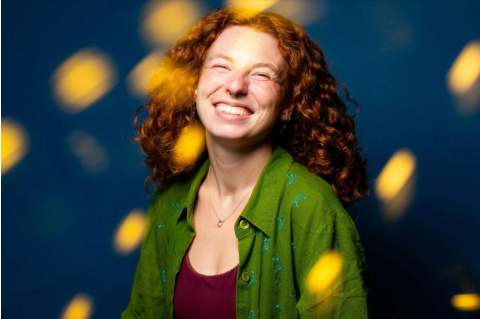
Olivia Gaunt’s Reach for the Stars
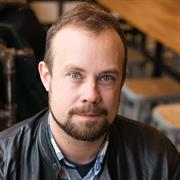
Timothy Atherton
Research/Areas of Interest: Condensed Matter Physics, Soft materials, Colloids, Liquid Crystals, Computational Physics, Physics Education Soft matter physics is the study of matter that is all around us in everyday life: soaps, oil, foods, sand, foams, and biological matter. All of these are readily deformable at room temperature and combine properties of both fluids and solids. Despite their ubiquity, these materials are extremely complicated. Unlike simple fluids like water, they have rich internal structure; unlike crystalline solids they are typically not periodically ordered. Moreover, they exist in long-lived metastable states far from equilibrium and respond to stimuli such as applied electric and magnetic fields, temperature and pressure. My work seeks to understand how these materials respond to shape: how they self-organize on curved surfaces or in complex geometries and how this knowledge can be used both to sculpt desirable shapes at the microscopic scale and create shape changing systems like soft robots. We use high performance computing to simulate and predict these behaviors and work closely with experimentalists at Tufts and beyond.

Pierre-Hugues Beauchemin
Research/Areas of Interest: Experimental High Energy Physics My research focuses on the discovery of new fundamental particles of nature, as well as on the understanding of the behavior of the known particles. To do this, I participate in the ATLAS experiment, one of the two general-purpose detectors at the Large Hadron Collider at CERN. My work currently consists in analyzing data in order to: Perform precision measurements leading to a better understanding of the strong interaction within the QCD theoretical framework; Search for new physics in events involving large amount of missing energy, typical signature of new particles that interact very weakly with normal matter such as dark matter candidate; Develop and estimate the performance of the ATLAS trigger system. This last aspect of my work also involves software development and a participation in the detector operation. I'm focusing my efforts on the Missing Energy trigger. The Standard Model of particle physics, despite being very successful, cannot be the end of the story. It contains a certain number of theoretical dissatisfactions. Of all the possibilities, I believe that dark matter is one of our best guess. Its existence is based on experimental facts, and the mass scale of dark matter particles, in the case where it is the right explanation, should be accessible at the LHC. Its existence would be inferred by the observation of missing energy in subset of all collected events. Looking for excesses of events involving large amount of missing energy over expectations is a promising way to look for dark matter at the LHC. My approach is to carry such search by performing precision measurements of Standard Model quantities, to optimize the sensitivity of the analysis to such new particles. Predictions using quantum chromodynamics (QCD) implies many approximations, assumptions or simplifications at various levels. These could lead to large systematic uncertainties on various Standard Model predictions, possibly leading to significant limits in our sensitivity to new phenomena. My research try to determine which of the simplifications and approximations are acceptable at the level of precision needed for a new physics discovery. To this end, I investigate events that contain a vector boson and jets, as they are sensitive to such physics and yet provide a clean enough environment to allow for high precision measurements. These are also the most important background to a wide range of new physics signature. As a side, I am also interested in the philosophy of physics, focusing on epistemological aspects of experiments and simulations as used in High Energy Physics.

Bruce Boghosian
Research/Areas of Interest: Applied dynamical systems, applied probability theory, kinetic theory, agent-based modeling, mathematical models of the economy, theoretical and computational fluid dynamics, complex systems science, quantum computation Current research emphasis is on mathematical models of economics in general, and agent-based models of wealth distributions in particular. The group's work has shed new light on the tendency of wealth to concentrate, and has discovered new results for upward mobility, wealth autocorrelation, and the flux of agents and wealth. The group's mathematical description of the phenomenon of oligarchy has also shed new light on functional analysis in general and distribution theory in particular. Secondary projects include new directions in lattice Boltzmann and lattice-gas models of fluid dynamics, kinetic theory, and quantum computation.

Research/Areas of Interest: Condensed Matter Physics
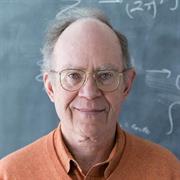
Lawrence Ford
Research/Areas of Interest: Theoretical cosmology, quantum field theory, models for quantum gravity effects My current research involves several related topics in quantum fluctuation phenomena, with applications to gravitation and cosmology. One topic is the study of energy density fluctuations for quantum fields such as the electromagnetic field. My collaborators and I have shown that large vacuum energy density fluctuations are more probable than previously expected. These large fluctuations can drive quantum fluctuations of gravity and provide insight into effects in quantum gravity, an area which is not well understood. Energy density fluctuations may also produce observable effects in atomic or condensed matter systems, and may play a role in the evolution of the early universe. I am also working on analog models for quantum gravity, in which quantum fluctuations in a nonlinear optical material might produce fluctuations in the speed of light, analogous to an effect expected in quantum gravity.
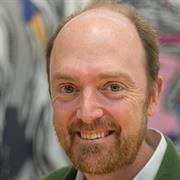
Hugh Gallagher
Research/Areas of Interest: Experimental particle physics, neutrino oscillations, neutrino interaction physics, neutrino astrophysics, computer simulations of neutrino-nucleus interactions. The main thrust of my research is the study of the neutrino. Through neutrino oscillation experiments, we are gaining insights into neutrino masses and mixing parameters. Precise measurements of these quantities may allow us to uncover the reason behind the matter-antimatter asymmetry in the universe, or point the way to a theory beyond the standard model. Precise measurements of oscillation parameters require good models of neutrino-nucleus interactions. I work on experiments that are studying neutrino oscillations (NOvA and DUNE), on experiments that are providing new data on neutrino-nucleus interactions (MINERvA), and on a widely-used software package (GENIE) that is used to simulate neutrino-nucleus interactions.
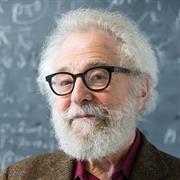
Gary Goldstein
Research/Areas of Interest: Theoretical high energy and nuclear physics, Science and society, Science education Theories of fundamental constituents of matter, Quantum Chromodynamics, tests of the Standard Model and beyond, the role of spin and angular momentum in particle interactions at medium and high energies. The role of science in public policy; non-proliferation of nuclear arms; education for peace.
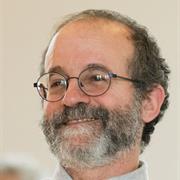
David Hammer
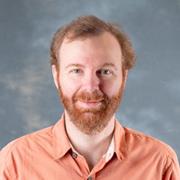
Mark Hertzberg
Research/Areas of Interest: Theoretical Physics: Cosmology, Particle Physics, Astrophysics. My primary research is in physics at the interface between theoretical cosmology and particle physics, including astrophysics and aspects of quantum field theory. By studying the extreme conditions of the very early universe, as well as the properties of the late universe's dark constituents, and analyzing the results of various ground based experiments, we can gain insights into the fundamental laws of nature. This acts as the driving force behind much of my research, although I sometimes investigate other interesting subjects. A central focus has been on trying to understand the nature of dark matter, which forms the majority of matter in the universe. There are various interesting candidates for the dark matter, including so-called axions, which may organize into new interesting types of structures. Furthermore, I have worked on the understanding the large scale structure of the universe, which gives insights into the initial conditions of the early universe. Another focus has been on understanding cosmological inflation, which is the leading idea for the earliest moments of our universe, involving an early phase of rapid expansion. I have worked on connecting inflation to the matter anti-matter asymmetry of the universe and worked on the post-inflationary era where the universe needs to transition to a hot soup of particles. A recent interest is in pursuing a fundamental understanding of gravitation. I am interested in understanding the full set of theoretical and observational constraints that determine the structure of gravitation, including constraints from quantum mechanics. Furthermore, I sometimes investigate interesting quantum phenomena, including entanglement entropy and the Casimir effect.
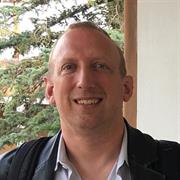
Research/Areas of Interest: Quantum Information, Quantum Simulation, Adiabatic Quantum Computation, Computational Physics Quantum information faces three basic questions. Firstly, what are quantum computers good for? Secondly, how do we build one? Thirdly, what will quantum information contribute if technological obstacles to constructing a large scale quantum computer prove insuperable? The first question is the search for problems which quantum computers can solve more easily than classical computers. The second is an investigation of which physical systems one could use to build a quantum computer. The third leads to the search for spinoffs in classical computation, and the question of where the classical/quantum boundary lies. I am interested in all three questions.
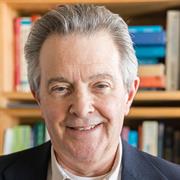
W. Anthony Mann
Research/Areas of Interest: Experimental high energy physics, elementary particle interactions, neutrino oscillations, neutrino-nucleus interactions, baryon instability searches. Design and execution of experimental measurements that reveal or constrain the existence of new elementary particles, that delineate the properties of known elementary particles, and that quantify the interactions and symmetries that govern fundamental energy systems of the subatomic realm.

Danilo Marchesini
Research/Areas of Interest: Astronomy; galaxy formation and evolution; extra-galactic surveys; active galactic nuclei; near-infrared astronomy Understanding how galaxies form and evolve means understanding how the tiny differences in the distribution of matter inferred from the cosmic microwave background radiation grew and evolved into the galaxies we see today. The working hypothesis is that galaxies form under the influence of gravity, and galaxy formation can be seen as a two-step process. First, the gravity of dark matter causes the tiny seeds in the matter distribution to grow bigger with time. As they grow more massive, the gravitational attraction becomes stronger, making it easier for these structures to attract additional matter. As the dark matter structures grow, they pull in also the gas, made of hydrogen and helium, which is the primary ingredient for the formation of stars, and hence for the formation of the stellar content of galaxies. The formation of the stellar content inside these dark matter structures involves many physical processes that are much more complicated and quite poorly understood from a theoretical perspective. These physical processes include, for example, how gas cools and collapses to form stars, the process of star formation itself, merging of galaxies, feedback from star formation and from active super-massive black holes. My research activity in the past decade has focused on understanding how galaxies formed after the Big Bang, and how their properties (e.g., the stellar mass, the level of star formation activity, the morphology and structural parameters, the level of activity of the hosted super-massive black hole, etc.) have changed as a function of cosmic time. Since we cannot follow the same galaxy evolving in time, we need to connect the galaxies we observe at a certain redshift (i.e. a certain snapshot in time) to those we observe at a smaller redshift (i.e., at a later time in cosmic history) in order to infer how the properties of galaxies have actually changed and what physical mechanisms are responsible for these changes. The better we understand the galaxy properties at a certain time and the more finely in time we can probe the cosmic history, the easier it becomes to connect galaxies' populations seen at different snapshots in time, linking progenitors and descendants across cosmic time. Ultimately, my research aims at understanding what galaxy population seen at one epoch will evolve into at a later epoch, and what physical processes are responsible for the inferred changes in the galaxies' properties. In order to do this, I have adopted two different but complementary approaches. The first approach consists of statistical studies of the galaxy populations at different cosmic times; the second approach consists of detailed studies of individual galaxies to robustly derive their properties.
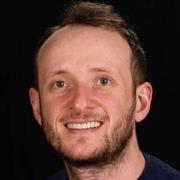
David Martin
Research/Areas of Interest: - Extra-solar planets "exoplanets" - Planets in multiple-star systems, including circumbinary planets - Stellar populations and fundamental parameters - White dwarfs - Black holes - M-dwarfs - Stellar activity (spots and flares) - Celestial mechanics, including the Kozai-Lidov effect - Planet formation - Observational astrophysics
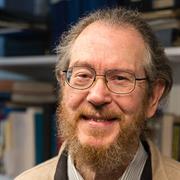
Austin Napier
Research/Areas of Interest: Experimental Particle Physics, Electromagnetic Theory, Computational Physics. High Energy Physics: studies of heavy quarks, new particle searches, tests of the Standard Model. Computational Physics: data analysis, simulation, electromagnetism.
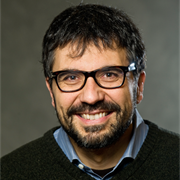
Fiorenzo Omenetto
Research/Areas of Interest: ultrafast nonlinear optics, nanophotonics, biopolymer multifunctional materials, material science, photonic crystals, photonic crystal fibers
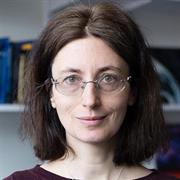
Anna Sajina
Research/Areas of Interest: Extragalactic astrophysics How did galaxies and their central black holes co-evolve from the Big Bang to the present? Despite much progress through large scale galaxy surveys as well as ever more sophisticated numerical simulations, we are still hampered by the fact that much of the star-formation activity and black hole growth are buried in thick cocoons of dust and gas. Observations suggest that much of this activity took place in the past, before the Universe was half its present age, and likely involved mergers of nearly equal sized galaxies. As the merger progresses, gas and dust are more and more concentrated, triggering prodigious star-formation and gradually increasing accretion onto the central black hole (Active Galactic Nuclei or AGN). The process is short lived as supernovae- or AGN-driven winds lead to a 'blow-out' event which disperses the intervening gas and dust halting further star-formation and black hole growth. Indications that starbursts and AGN may regulate each other as above can be seen in the local correlation between the mass of a central black hole and the stellar mass of its host galaxy. The same galaxy observed at different stages of this process can appear very different. Therefore observations of different types of galaxies at different epochs and in different wavelength regimes are crucial to build a more complete understanding of the whole process.
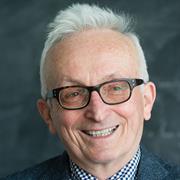
Krzysztof Sliwa
Research/Areas of Interest: Physics of elementary particles The Standard Model, gauge theories; also topology, differential geometry and other branches of modern mathematics to better understand quantum gauge theories, the origin of mass and the structure of space-time, matter and all interactions, including gravity. I am a member of the ATLAS collaboration at the LHC. Studies of Higgs boson and top quarks. The main objective is to find out whether the new particle discovered in 2012 is a minimal Standard Model Higgs, or some other kind. Studies of top quarks are very interesting on their own. Because of very large mass of the top quark, its lifetime is very short, ~ 5x10^{-25} seconds, much shorter that the characteristic time of the strong interactions. As a consequence, top quark decays before any strong interaction effects may take place. This allows a direct access to the information about the quark spin, which is very difficult, if not impossible, for any other quark. Studies of top quarks are very important for other searches, as top quarks will constitute the most important background for almost any final states due to "new physics" and have to be understood very well. We are using very advanced multidimensional analysis techniques, developed by our group (Ben Whitehouse and I). Topology and geometry of the Universe In the Standard Cosmological Model (SCM), the starting point is an interpretation of the observed redshift of spectral lines from distant galaxies as a Doppler shift in the frequency of light waves as they travel through an expanding Universe. Acceptance of this hypothesis led to the ideas of the Big Bang and the LambdaCDM, the Standard Model of cosmology. Remarkably, there exist another explanation of the cosmological redshift. As shown by Irving Ezra Segal, a mathematician and a mathematical physicist, the same axioms of global isotropy and homogeneity of space and time, and its causality properties, are satisfied not only by the Minkowski spacetime R x R^3, but also by a Universe whose geometry is R X S^3. In Segal's model, the geometry of the spatial part of the Universe is that of a three-dimensional hypersurface of a four-dimensional sphere. Locally, it is indistinguishable from the flat Minkowski spacetime. It is the geometry of the Einstein static Universe, which he abandoned when the interpretation of the increase of redshift with distance was universally accepted as evidence for expanding Universe. The redshift in Segal's model arises in a geometric way analogously to distortions which appear when making maps using stereographic projection from S^2, a two-dimensional curved surface of a sphere in three dimensions, onto a flat surface of a map, R^2. Segal's theory makes a verifiable prediction for the redshift as a function of distance. The comparison, although in principle very simple, is non-trivial. For more distant objects, one can only estimate the distance using various proxies, for example the magnitude, if one assumes that the chosen sources have the same absolute luminosity. Surprisingly, Segal's model cannot be falsified with the currently available data. The magnitude-redshift data for supernovae agree very well with SCM, but it also agrees with Segal's model. There exist another independent observable, the number of observed galaxies as a function of redshift z, N(< z). Assuming that galaxies are uniformly distributed in the Universe, their number is proportional to the volume enclosed in a given fixed angular field of view, and the dependence of this volume on the manifold distance is sensitive to the geometry of the Universe. Two Tufts undergraduate students, Maxwell Kaye and Nathan Burwig, joined me in this analysis. We examined the data from several Hubble Deep Fields, and found that the number of observed galaxies as a function of redshift is also in very good agreement with Segal's model. We are continuing with a study of these fundamental questions about the topology and geometry of our Universe. Interestingly, I have also shown recently that one can explain the observed value of the CMB temperature, following Segal's original idea that the CMB appears unavoidably as a result of light traveling many times around a closed spatial part of the R X S^3 Universe. Magnetic monopoles I am also a member of MoEDAL, a small collaboration looking for magnetic monopoles at the LHC.
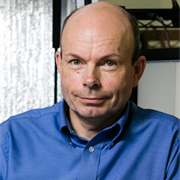
Igor Sokolov
Research/Areas of Interest: Engineering for Health -> Physics of cancer and aging -> Mechanics of biomaterials at the nanoscale, Synthesis and study of functionals nanomaterials for biomedical imaging and drug delivery, Advanced imaging for medical diagnostics, Novel processes and materials for dentistry: nano-polishing and self-healing materials
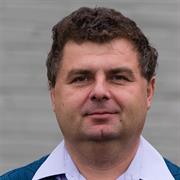
Cristian Staii
Research/Areas of Interest: Biological Physics, Condensed Matter Physics, Quantum Mechanics My research interests cover a broad array of topics in biological physics, condensed matter physics and quantum mechanics. In biological physics our group is performing both experimental and theoretical work to uncover fundamental physical principles that underlie the formation of functional neuronal networks among neurons in the brain. One of the primary challenges in science today is to figure out how as many as 100 billion neurons are produced, grow, and organize themselves into the truly wonderful information-processing machine which is the brain. We combine high-resolution imaging techniques such as atomic force, traction force and fluorescence microscopy to measure mechanical properties of neurons and to correlate these properties with internal components of the cell. Our group is also using mathematical modeling based on stochastic differential equations and the theory of dynamical systems to predict axonal growth and the formation of neuronal networks. The aim of this work is twofold. On the one hand we are using tools and concepts from experimental and theoretical physics to understand biological processes. On the other hand, active biological processes in neuronal cells exhibit a wealth of fascinating phenomena such as feedback control, pattern formation, collective behavior, and non equilibrium dynamics, and thus the insights learned from studying these biological systems broaden the intellectual range of physics. I am also interested in the foundations of quantum mechanics, particularly in decoherence phenomena and in applying the theory of stochastic processes to open quantum systems. My interests in condensed matter physics include quantum transport in nanoscale systems (carbon nanotubes, graphene, polymer composites, hybrid nanostructures), as well as scanning probe microscopy investigations of novel biomaterials.

Roger Tobin
Research/Areas of Interest: Experimental condensed matter physics; physics education My primary physics research is in experimental surface science. In my lab at 574 Boston Ave., my students and I study what happens when foreign atoms and molecules form chemical bonds with metal surfaces. We examine how the interaction between the foreign molecule and the metal modify properties of both of them. In recent years a particular focus has been on how the attachment of the foreign molecule changes the electrical resistivity of the metal substrate. This area of research has relevance to a range of potential applications including catalysis, chemical sensing, and the growth of thin films and nanoparticles on surfaces. A second area of activity is physics education, particularly at the elementary school level. Together with collaborators at a local nonprofit organization and at other universities, I am working to develop and study curriculum materials and professional development strategies for teachers to improve instruction in science in grades 3-5.
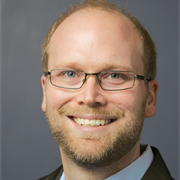
Thomas Vandervelde
Research/Areas of Interest: Interaction of light with matter, physics of nanostructures and interfaces, metamaterials, material science, plasmonics, and surfactants, semiconductor photonics and electronics, epitaxial crystal growth, materials and devices for energy and infrared applications.
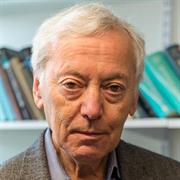
Alexander Vilenkin
Research/Areas of Interest: Theoretical cosmology I do research on cosmic inflation, dark energy, cosmic strings and monopoles, quantum cosmology, and the multiverse.
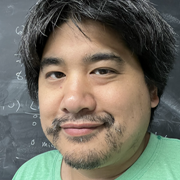
Taritree Wongjirad
Research/Areas of Interest: My current focus is on measuring the properties of the neutrino, one of the fundamental particles of the Standard Model. We know a few things about the neutrino: it has a very small mass, has no electric charge, comes in three types — or flavors — and interacts only via the weak force and gravity. However, there are many things we do not know. What is the exact mass of the neutrino? And how does it get its mass? Are the three we know about the only kinds that exist? Answers to these questions impact not only our understanding of the fundamental laws of matter but also have consequences for our understanding of how the universe evolved. These and many other questions make the neutrino a fascinating particle. However, as mentioned above, neutrinos interact only via the weak force. They interact so rarely that, at the energies, we typically work with, neutrinos can pass through light-years long block of lead without striking it. This makes neutrino experiments challenging as we need to build massive, building-sized detectors which are instrumented with relatively, low-cost sensors. However, the challenge is often fun, as we are often forced to apply the newest technologies in both hardware and software to design and complete our experiments.
Related Programs
Chemistry: chemical physics.

- Publications
- Opportunities

CARNEGIE THEORETICAL ASTROPHYSICS CENTER
Theory plays an increasingly important role in astronomy to interpret data, predict new phenomena, and inform observing strategies. The Carnegie Theoretical Astrophysics Center (CTAC) brings theorists and observers together at the cutting edge of astrophysical research to better understand the mysteries of the universe.
Research Topics
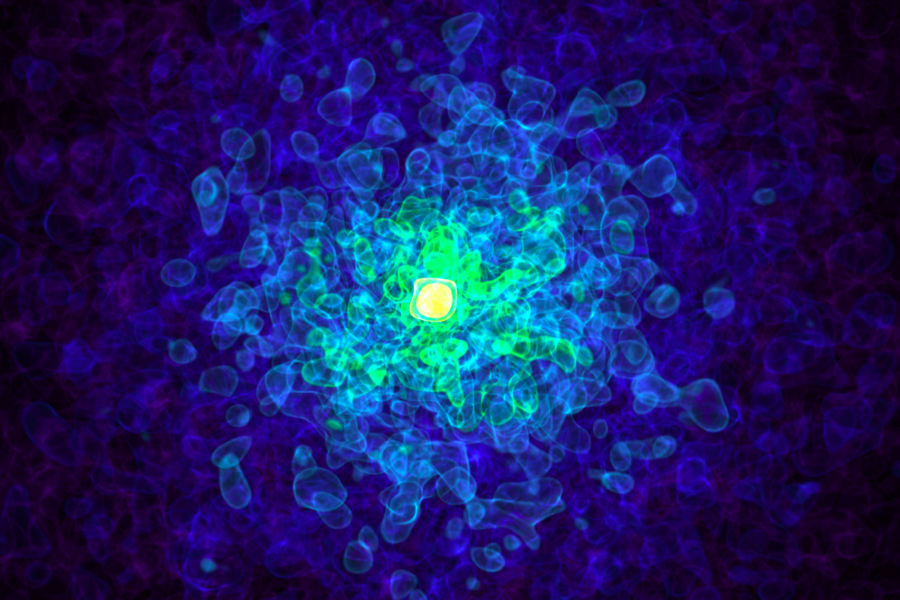
Dark Matter
Galaxy formation and evolution, high energy astrophysics.
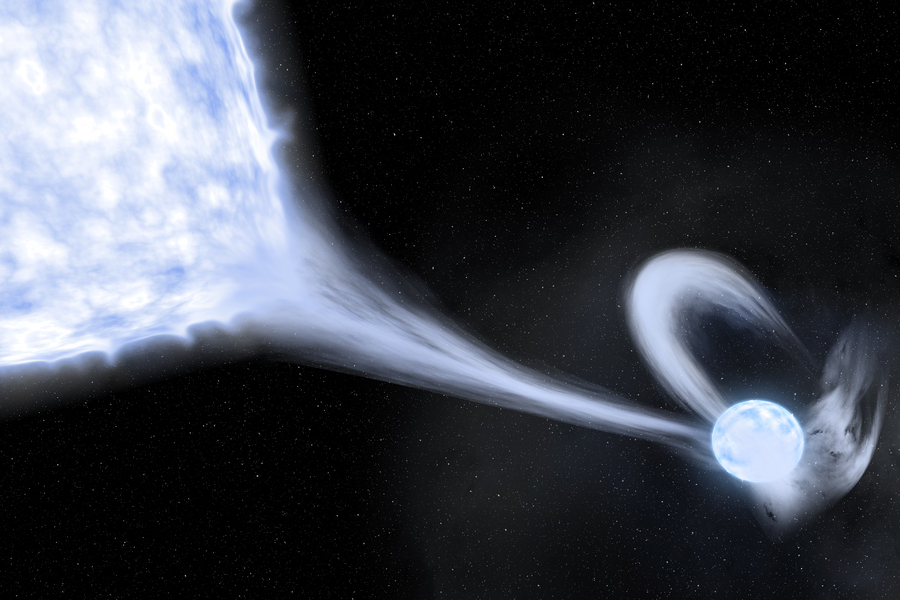
Stellar Evolution
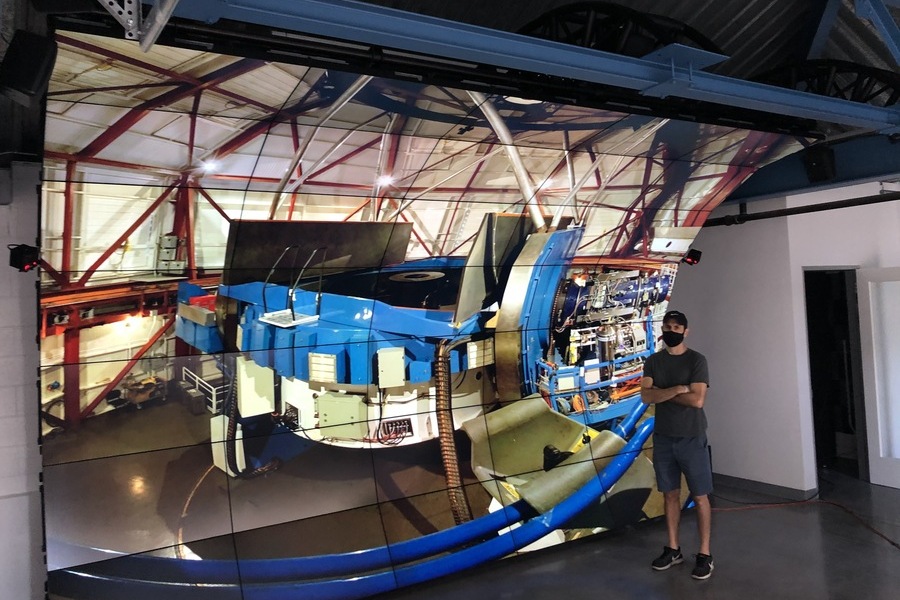
Visualization Laboratory
Astrophysical Sciences and Technology Doctor of Philosophy (Ph.D.) Degree

Request Info about graduate study Visit Apply
An astrophysics Ph.D. centered on phenomena beyond the Earth and on the development of the technologies that will enable the next major strides in the field.
Co-op/Internship Encouraged
STEM-OPT Visa Eligible
Overview for Astrophysical Sciences and Technology Ph.D.
Why study astrophysical sciences at rit.
- Unique Interdisciplinary Approach: This multidisciplinary program is administered by the School of Physics and Astronomy , in collaboration with the School of Mathematics and Statistics and the Chester F. Carlson Center for Imaging Science , setting it apart from conventional astrophysics graduate programs at traditional research universities.
- Tailored to your Interests: The program offers tracks in astrophysics (including observational and theoretical astrophysics), computational and gravitational astrophysics (including numerical relativity, gravitational wave astronomy), and astronomical technology (including detector and instrumentation research and development).
- Participate in Research: Students may participate in one of three research centers associated with the School of Physics and Astronomy: the Center for Computational Relativity and Gravitation , the Center for Detectors or the Laboratory for Multi-wavelength Astrophysics .
- Industry Opportunities: Graduates of the program have secured roles at the Dudley Observatory at the Museum of Innovation & Science, the National Radio Astronomy Observatory, in higher education institutions, among others.
There has never been a more exciting time to study the universe beyond the confines of the Earth. A new generation of advanced ground-based and space-borne telescopes and enormous increases in computing power are enabling a golden age of astrophysics. The doctoral program in astrophysical sciences and technology focuses on the underlying physics of phenomena beyond the Earth and on the development of the technologies, instruments, data analysis, and modeling techniques that will enable the next major strides in the field. The program's multidisciplinary emphasis sets it apart from conventional astrophysics graduate programs at traditional research universities.
The program offers tracks in astrophysics (including observational and theoretical astrophysics), computational and gravitational astrophysics (including numerical relativity, gravitational wave astronomy), and astronomical technology (including detector and instrumentation research and development). Students can pursue research interests in a wide range of topics, including design and development of novel detectors, multiwavelength studies of proto-stars, active galactic nuclei and galaxy clusters, gravitational wave data analysis, and theoretical and computational modeling of astrophysical systems including galaxies and compact objects such as binary black holes. Depending on research interests, students may participate in one of three research centers: the Center for Computational Relativity and Gravitation (Video) , the Center for Detectors , or the Laboratory for Multi-wavelength Astrophysics.
Plan of Study
In the astrophysics Ph.D., students complete a minimum of 60 credit hours of study, consisting of at least 24 credit hours of course work and at least 24 credit hours of research. Students may choose to follow one of three tracks: astrophysics, astroinformatics and computational astrophysics (with the option of a concentration in general relativity), or astronomical instrumentation. All students must complete four core courses with grades of B or better, as well as two semesters of a graduate seminar. Core course grades below B must be remediated by taking and passing a comprehensive exam on the core course subject matter prior to receiving the doctoral degree. The remaining course credits are made up from specialty track courses and electives. Students must pass a qualifying examination, which consists of completing and defending a master's-level research project, prior to embarking on the dissertation research project.
Electives include additional courses in astrophysics and a wide selection of courses offered in other RIT graduate programs (e.g., imaging science, computer science, engineering), including detector development, digital image processing, computational techniques, optics, and entrepreneurship, among others.
Ph.D. qualification requirements: Master's-level research project
During the first year of the program, most doctoral candidates begin a master's-level research project under the guidance of a faculty member. The project gains momentum during the second year after the core courses have been completed. The master's-level research topic may be different from the eventual doctoral dissertation topic, and the supervising faculty member will not necessarily serve as the dissertation research advisor.
The doctoral qualification requirements consist of a combination of a publication-quality master's-level project report, which may be in the form of a thesis (if the student so chooses) and an oral presentation and defense of the master's-level project. This qualification process, which must be completed by the beginning of the third year of full-time study or its equivalent, is designed to ensure the student has the necessary background knowledge and intellectual skills to carry out doctoral-level research in the subject areas of astrophysical sciences and technology. A director-approved committee consisting of the student's master's-level project research advisor and two additional faculty members will assess the student's project report and defense.
Dissertation research advisor
After passing the qualifying examination, students are guided by a dissertation research advisor who is approved by the program director. The choice of advisor is based on the student's research interests, faculty research interests, and available research funding.
Research committee
After passing the qualifying examination, a dissertation committee is appointed for the duration of the student's tenure in the program. The committee chair is appointed by the dean of graduate education and must be a faculty member in a program other than astrophysical sciences and technology. The committee chair acts as the institutional representative in the final dissertation examination. The committee comprises at least four members and in addition to the chair, must also include the student's dissertation research advisor and at least one other member of the program's faculty. The fourth member may be an RIT faculty member, a professional affiliated in industry, or a representative from another institution. The program director must approve committee members who are not RIT faculty.
Ph.D. proposal review (candidacy exam)
Within six months of the appointment of the dissertation committee, students must prepare a Ph.D. research project proposal and present it to the committee for review. The student provides a written research proposal and gives an oral presentation to the committee, who provides constructive feedback on the project plan. The review must take place at least six months prior to the dissertation defense.
Annual review
Each fall, students provide an annual report in the form of an oral presentation, which summarizes progress made during the preceding year. The program director also monitors student's progress toward meeting the requirements for either the qualifying examination (during the first two years), or the Ph.D. (after passing the qualifying examination). Students may be interviewed, as necessary, to explore any concerns that emerge during the review and to discuss remedial actions.
Final examination of the dissertation
Once the dissertation is written, distributed to the dissertation committee, and the committee agrees to administer the final examination, the doctoral candidate may schedule the final examination. The candidate must distribute a copy of the dissertation to the committee and make the dissertation available to interested faculty at least four weeks prior to the dissertation defense.
The final examination of the dissertation is open to the public and is primarily a defense of the dissertation research. The examination consists of an oral presentation by the student, followed by questions from the audience. The dissertation committee privately questions the candidate following the presentation. The dissertation committee caucuses immediately following the examination and thereafter notifies the candidate and the program director of the results.
All students in the program must spend at least one year (summer term excluded) in residence as full-time students to be eligible to receive the doctorate degree.
Time Limitations
All doctoral candidates must maintain continuous enrollment during the research phase of the program. Normally, full-time students complete the course of study in approximately four to five years. A total of seven years is allowed to complete the requirements after first attempting the qualifying examination.
Students are also interested in: Astrophysical Sciences and Technology MS , Physics MS
The astrophysical sciences and technology program offers students a wide range of research opportunities spanning observational and theoretical astrophysics, computational astrophysics, general relativity and gravitational wave astronomy, and the design and development of advanced detectors and instrumentation for astronomy. RIT hosts a vibrant astronomy and astrophysics research community of more than 60 faculty, post-docs, research fellows, and graduate students who participate in three designated research centers:
- The Center for Computational Relativity and Gravitation
- The Center for Detectors
- Laboratory for Multiwavelength Astrophysics
Faculty and students frequently obtain data from space observatories including the Hubble Space Telescope , the Spitzer Space Telescope , the Chandra X-ray Observatory , the Herschel Space Observatory , and various ground-based observatories such as the Gemini Observatory , twin 8.1-meter diameter optical/infrared telescopes located in Hawaii and Chile, the W. M. Keck Observatory on Hawaii, and the Very Large Array radio telescope facility in New Mexico. RIT is a member of the LIGO Scientific Collaboration , which analyzes the data taken by the Laser Interferometer Gravitational-Wave Observatory , and a member of the Legacy Survey of Space Time Corporation , which will operate an 8.4 m telescope at the Vera C. Rubin Observatory in Chile, to conduct a 10-year survey of the Southern skies.
Computing facilities include the GravitySimulator supercomputer, dedicated to N-body simulations of galactic nuclei and stellar clusters and the NewHorizons computer cluster, for numerical relativity and relativistic hydrodynamics simulations. Funding has recently been obtained to acquire an even more powerful 600-core cluster (BlueSky). Researchers at RIT's Center for Computational Relativity and Gravitation also have access to national supercomputing facilities, such as the Blue Waters supercomputer at the National Center for Supercomputing Applications at the University of Illinois at Urbana-Champaign.
Faculty involved in the astrophysical sciences and technology program regularly attract substantial external research funding from national and state agencies, including funding support from NASA , National Science Foundation , NYSTAR (Empire State Development Division of Science, Technology, and Innovation), amounting to over $12 million in the last four years.
Current research interests include:
- Strong-field gravitational dynamics of interacting compact objects such as black holes and neutron stars
- Magnetohydrodynamical simulations of the accretion disks and other astrophysical environments around supermassive black-holes
- Detection of gravitational wave signatures of binary black holes and/or neutron stars in close binary orbits
- Single Photon Counting Detectors for NASA Astronomy Missions
- New Infrared Detectors for Astrophysics
- Microgrid polarizer arrays
- Young stars and proto-planetary disks
- Chandra Planetary Nebula Survey
- Feeding and Feedback in Active Galactic Nebulae (AGN)
- AGN feedback in galaxy clusters
- Supermassive black holes in low redshift elliptical galaxies
- Reverberation mapping the circum-nuclear torus in AGN
- Stellar dynamics and supermassive black holes in galactic nuclei
- Hydrodynamical signatures of dark-matter dominated satellite galaxies
Careers and Experiential Learning
National labs career events and recruiting.
The Office of Career Services and Cooperative Education offers National Labs and federally-funded Research Centers from all research areas and sponsoring agencies a variety of options to connect with and recruit students. Students connect with employer partners to gather information on their laboratories and explore co-op, internship, research, and full-time opportunities. These national labs focus on scientific discovery, clean energy development, national security, technology advancements, and more. Recruiting events include our university-wide Fall Career Fair, on-campus and virtual interviews, information sessions, 1:1 networking with lab representatives, and a National Labs Resume Book available to all labs.

Jeyhan Kartaltepe

Michael Zemcov

Manuela Campanelli
Featured Work
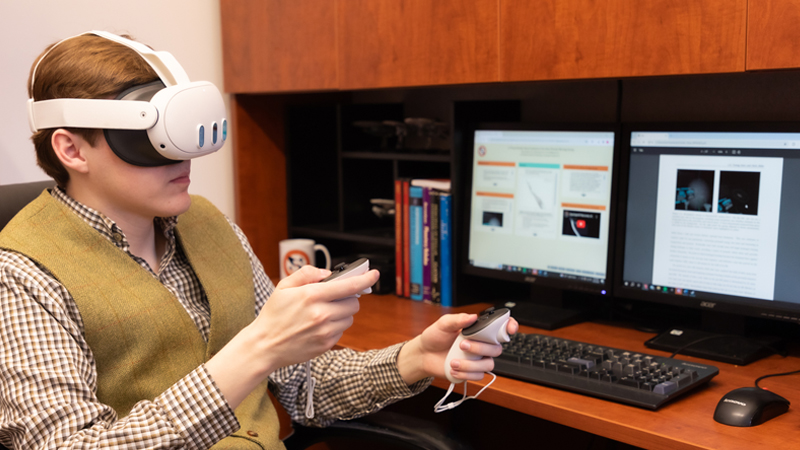
Exploring the Potential of Virtual Reality for Analyzing Astronomical Data
Ryan Butler (astrophysical science and technology)
Ryan Butler, a Ph.D. candidate in the Astrophysical Science and Technology program at RIT, is exploring the use of virtual reality to analyze astronomical data.

Astrophysics Ph.D. Research: How Galaxies Form and Evolve
Brittany Vanderhoof (astrophysical sciences and technology)
Ph.D. student Brittany Vanderhoof chose RIT for the diverse range of research and accessibility of professors. Now she’s growing as an astrophysicist and researching how galaxies form and evolve.
Featured Profiles
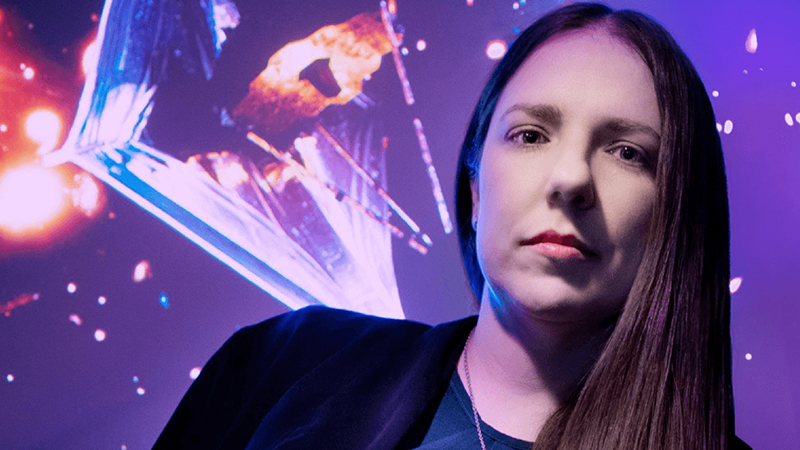
Unfolding the Universe
RIT astrophysicist, Jeyhan Kartaltepe, puts students first while researching the origins of thousands of galaxies.

Navigating Research Policy with Senior Research Officers
Kevin Cooke ’19 found his calling at the intersection of science and policy while pursuing his Ph.D. at RIT. Now, he’s the Director of Research Policy at APLU.
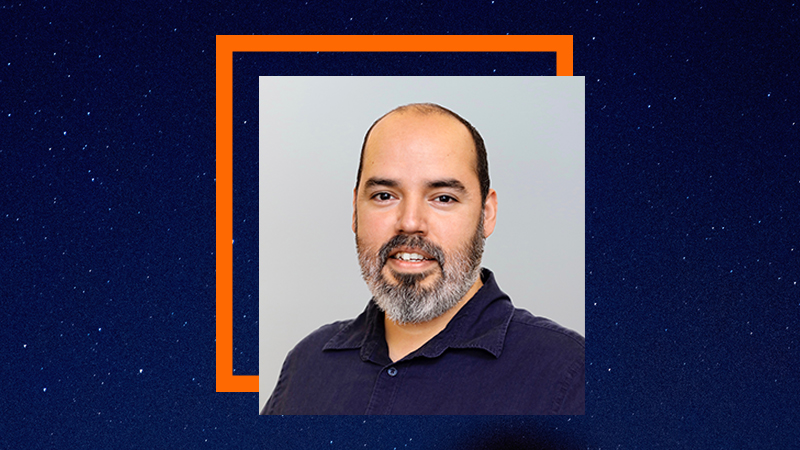
AST Program Grad is now Researching Stars at the Smithsonian
Rodolfo (Rudy) Montez Jr. ’10 (astrophysical and technology)
RIT Astrophysical Sciences and Technology Ph.D. graduate Rodolfo (Rudy) Montez Jr. ’10 is now an Astrophysicist researching stars at the Center for Astrophysics | Harvard & Smithsonian.
Latest News
April 2, 2024
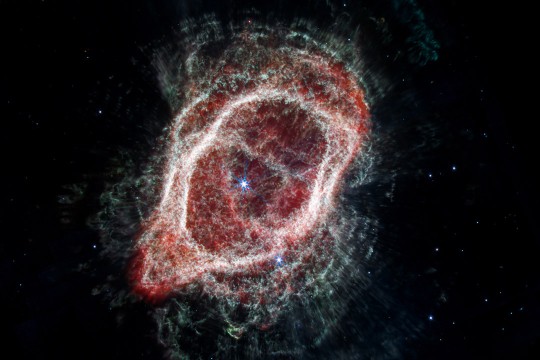
Scientists release new insight about Southern Ring Nebula
Planetary nebulae have been studied for centuries, but astronomers are getting new looks and a better understanding of the structures and compositions of these gaseous remnants of dying stars thanks to the ability to study objects at multiple wavelengths and dimensions.
January 24, 2024
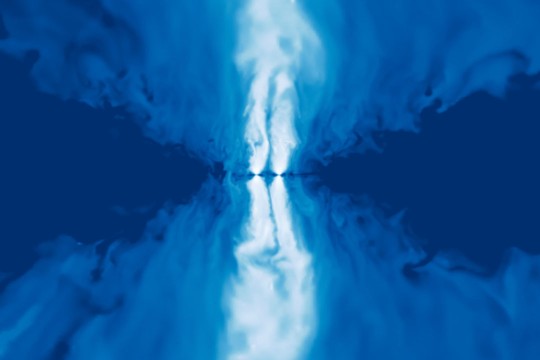
RIT leading NASA-funded supermassive black hole research
RIT scientists will be the lead researchers on a $1.8 million NASA grant to study electromagnetic signals from merging supermassive black holes.
July 25, 2023
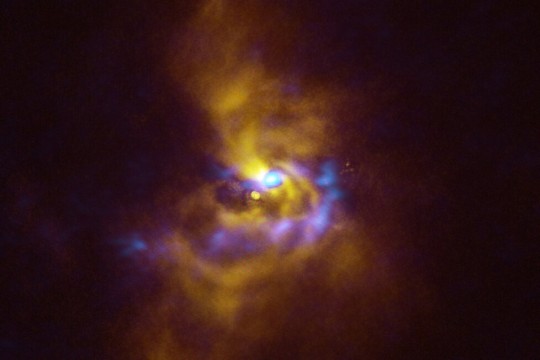
RIT professor co-authors paper on new planetary formation findings
Joel Kastner, a professor in the Chester F. Carlson Center for Imaging Science and School of Physics and Astronomy, and a team of researchers with the European Southern Observatory have discovered new evidence of how planets as massive as Jupiter can form.
Curriculum for 2023-2024 for Astrophysical Sciences and Technology Ph.D.
Current Students: See Curriculum Requirements
Astrophysical Sciences and Technology, Ph.D. degree, typical course sequence
Specialty tracks, astroinformatics, gravitational wave astronomy, instrumentation, numerical relativity, observational astrophysics, theoretical astrophysics, admissions and financial aid.
This program is available on-campus only.
Full-time study is 9+ semester credit hours. International students requiring a visa to study at the RIT Rochester campus must study full‑time.
Application Details
To be considered for admission to the Astrophysical Sciences and Technology Ph.D. program, candidates must fulfill the following requirements:
- Complete an online graduate application .
- Submit copies of official transcript(s) (in English) of all previously completed undergraduate and graduate course work, including any transfer credit earned.
- Hold a baccalaureate degree (or US equivalent) from an accredited university or college.
- A recommended minimum cumulative GPA of 3.0 (or equivalent).
- Submit a current resume or curriculum vitae.
- Submit a statement of purpose for research which will allow the Admissions Committee to learn the most about you as a prospective researcher.
- Submit two letters of recommendation .
- Entrance exam requirements: None
- Writing samples are optional.
- Submit English language test scores (TOEFL, IELTS, PTE Academic), if required. Details are below.
English Language Test Scores
International applicants whose native language is not English must submit one of the following official English language test scores. Some international applicants may be considered for an English test requirement waiver .
International students below the minimum requirement may be considered for conditional admission. Each program requires balanced sub-scores when determining an applicant’s need for additional English language courses.
How to Apply Start or Manage Your Application
Cost and Financial Aid
An RIT graduate degree is an investment with lifelong returns. Ph.D. students typically receive full tuition and an RIT Graduate Assistantship that will consist of a research assistantship (stipend) or a teaching assistantship (salary).
Graduate Admissions
The selection of the Ph.D. students admitted to the Department of Physics is based on an individualized, holistic review of each application, including (but not limited to) the student's academic record, the letters of recommendation, the statement of purpose, past accomplishments, and talent for research in physics. Applicants should keep in mind that attributes such as persistence, enthusiasm, and intellectual creativity can play a significant role in the evaluation of the aptitude of a candidate to graduate school.
For the 2024-25 application cycle, the General GRE or Physics GRE scores will be accepted but are not a required part of a complete application.
Applications must be submitted by the middle of December to be considered for the following Autumn Quarter. In January and February of each year, the Physics Department Graduate Admission Committee reviews each application. All applicants will be notified of their admission status by March 1st.
The Physics Department recognizes that the Supreme Court issued a ruling in June 2023 about the consideration of certain types of demographic information as part of an admission review. All applications submitted during upcoming application cycles will be reviewed in conformance with that decision. The Department does not offer a separate program for the M.S. degree, but this degree may be awarded for a portion of the Ph.D. degree work with approval from the Department. Graduate students have opportunities for research in theoretical physics, AMO physics, ultra-fast lasers, particle and nuclear physics, condensed matter physics, quantum information and control, cosmology, astrophysics, and gravitation. Opportunities for research are also available with the faculty at SLAC National Accelerator Laboratory in the areas of theoretical and experimental particle physics, cosmology and astrophysics, accelerator design, and photon science. In Applied Physics there are opportunities in the areas of theoretical and experimental condensed matter physics, materials research, quantum electronics, and novel imaging technology.
The application deadline for this academic year 2023-24 (2024-25 admissions cycle) is 11:59pm Pacific Standard Time, Friday, December 15, 2023 . The application submission deadline is a hard deadline and no late applications are accepted, no exceptions. We strongly suggest you do not wait until the last day to submit in case you encounter any difficulties.
- Three letters of recommendation, preferably including at least one from a research group.
- Upload one scanned version of your official transcript(s) in the online application (see File Upload Requirements ). Official transcripts are preferred, however, if obtaining official transcripts is financially burdensome, we will accept unofficial transcripts at the time of application. For those that are offered admission to our program, we will require submission of official transcripts for accepted students before matriculation.
- The TOEFL exam is required for applicants whose first language is not English. It must be taken within the last two years. The TOEFL is waived for applicants who have recently completed or will complete a Bachelor's degree, or a 2-year Master's program, in the U.S. or in another English-speaking country. See the Graduate Admissions GRE/TOEFL FAQ for detailed information.
- The GRE General and Physics exam scores will be accepted but are not required in the 2024-25 application cycle (2023-24 academic year).
The Department of Physics welcomes graduate applications from individuals with a broad range of life experiences, perspectives, and backgrounds who would contribute to our community of scholars. Review of applications is holistic and individualized, considering each applicant’s academic record and accomplishments, letters of recommendation, and admissions essays in order to understand how an applicant’s life experiences have shaped their past and potential contributions to their field.
The department is interested in understanding and mitigating barriers to access to all of our programs, including barriers based on citizenship status, accessibility, or financial or logistical challenges. If you are interested in our graduate program but there are barriers that limit your ability to apply given our current procedures, we would appreciate hearing from you. Please fill out this brief form .
Not all students have equal access to information on the graduate admission process. The department is interested in helping those who may need additional guidance in applying to graduate programs in Physics. If you are interested in attending a Q&A panel to hear from current graduate students about applying to graduate programs please fill out this form .
https://forms.gle/oY6y9L3dpHQe9XN47
ADDITIONAL QUESTIONS
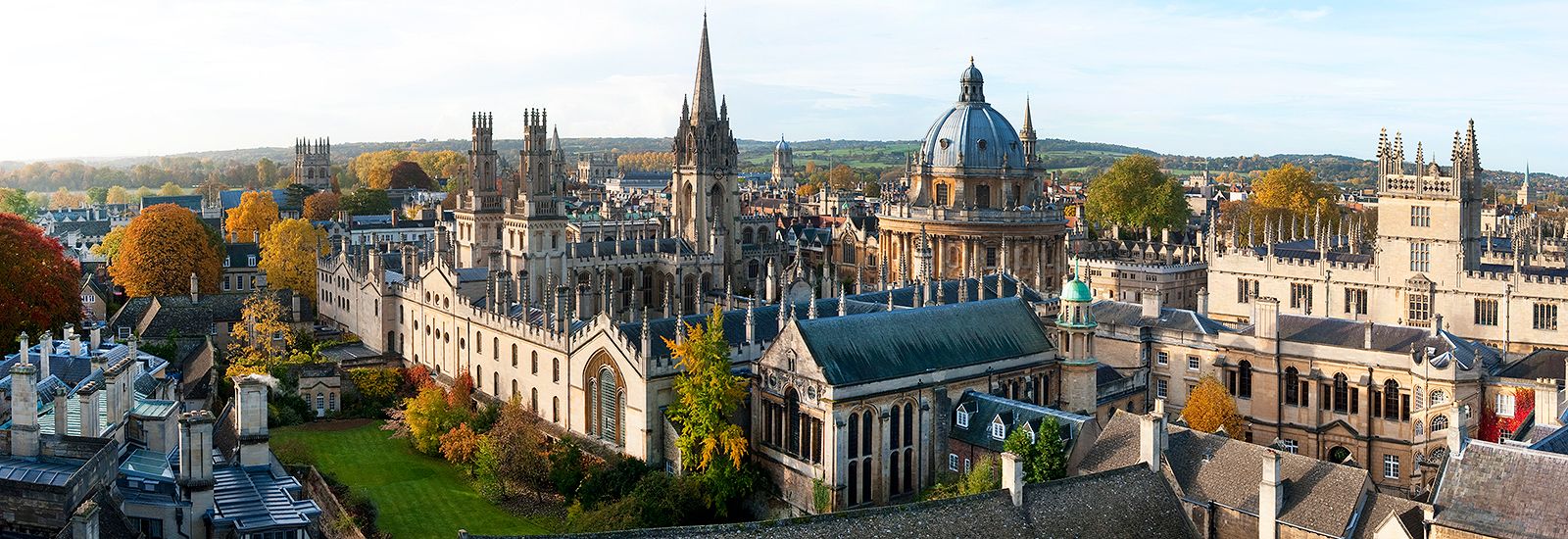
DPhil in Theoretical Physics
- Entry requirements
- Funding and Costs
College preference
- How to Apply
About the course
The DPhil in Theoretical Physics is a research-based course of three to four years in duration. Students working towards their DPhil in Theoretical Physics can choose from topics ranging from astrophysics and plasma physics to condensed matter theory to particle theory and we collaborate with experimentalists in other sub-departments and worldwide. There are also theoretical projects available in other sub-departments.
You will be assigned to a research group: work on your original research project will start immediately and continue for the duration of your DPhil. Your research project will be your main focus throughout your DPhil, but to increase your basic and specialist physics knowledge you will be required to attend lectures and courses in your first year. This includes courses from the MMathPhys programme, as well as the seminars and colloquia that are regularly held in the department.
During your Dphil you are encouraged to attend conferences and summer schools inside or outside the UK and the department supports such attendance financially.

Supervision
The allocation of graduate supervision for this course is the responsibility of the Department of Physics and it is not always possible to accommodate the preferences of incoming graduate students to work with a particular member of staff. Under exceptional circumstances, a supervisor may be found outside the Department of Physics.
The frequency of student supervisor meetings varies depending on the nature of the project; students should expect to interact with supervisors regularly, eg weekly or, in some cases, monthly. You are welcome to contact potential supervisors for further information.
At the end of the first year you are expected to submit a report on your research and to defend it in an interview with the Graduate Studies Panel and a specialist reader. The panel will determine whether you can transfer status from Probationer Research Student (PRS) status to DPhil student status.
You will be expected to submit a substantial original thesis after three or, at most, four years from the date of admission. To be successfully awarded a DPhil you will need to defend your thesis orally ( viva voce ) in front of two appointed examiners.
Graduate destinations
The DPhil in Theoretical Physics at Oxford is ideally suited to those students who would like to pursue a career in research; either in academia or industry all over the world. The majority of alumni go on to take up postdoctoral research posts after graduation.
However, a very wide range of career paths is possible, with recent graduates taking up positions in investment banking, business analysis and consulting.
Changes to this course and your supervision
The University will seek to deliver this course in accordance with the description set out in this course page. However, there may be situations in which it is desirable or necessary for the University to make changes in course provision, either before or after registration. The safety of students, staff and visitors is paramount and major changes to delivery or services may have to be made in circumstances of a pandemic, epidemic or local health emergency. In addition, in certain circumstances, for example due to visa difficulties or because the health needs of students cannot be met, it may be necessary to make adjustments to course requirements for international study.
Where possible your academic supervisor will not change for the duration of your course. However, it may be necessary to assign a new academic supervisor during the course of study or before registration for reasons which might include illness, sabbatical leave, parental leave or change in employment.
For further information please see our page on changes to courses and the provisions of the student contract regarding changes to courses.
Entry requirements for entry in 2024-25
Proven and potential academic excellence.
The requirements described below are specific to this course and apply only in the year of entry that is shown. You can use our interactive tool to help you evaluate whether your application is likely to be competitive .
Please be aware that any studentships that are linked to this course may have different or additional requirements and you should read any studentship information carefully before applying.
Degree-level qualifications
As a minimum, applicants should hold or be predicted to achieve the following UK qualifications or their equivalent:
- a first-class or strong upper second-class undergraduate degree with honours in physics, mathematics or another relevant science. The equivalent of a UK four-year integrated MPhys or MSci degree is typically required. Bachelor's degrees with a minimum four years' standard duration may satisfy the entry requirements.
Entrance is very competitive and most successful applicants have a first-class degree or the equivalent. In exceptional cases, the requirement for a first-class or strong upper-second class undergraduate degree with honours can be alternatively demonstrated by a graduate master’s degree or substantial directly-related professional or research experience.
For applicants with a degree from the USA, the typical minimum GPA sought is 3.3 out of 4.0. However, selection of candidates also depends on other factors in your application and most successful applicants have achieved higher GPA scores.
If your degree is not from the UK or another country specified above, visit our International Qualifications page for guidance on the qualifications and grades that would usually be considered to meet the University’s minimum entry requirements.
GRE General Test scores
No Graduate Record Examination (GRE) or GMAT scores are sought.
Other qualifications, evidence of excellence and relevant experience
It is helpful to include details of any of the following applicable attributes, which may strengthen your application:
- Details of any publications. Many candidates with no peer-reviewed publications receive offers each year.
- Research or professional experience in areas aligned with the proposed supervisors' research interests.
- Depending on the project, evidence of training in scientific computer programming or related numerical techniques.
- Previous experience in a scientific or technical research environment.
English language proficiency
This course requires proficiency in English at the University's standard level . If your first language is not English, you may need to provide evidence that you meet this requirement. The minimum scores required to meet the University's standard level are detailed in the table below.
*Previously known as the Cambridge Certificate of Advanced English or Cambridge English: Advanced (CAE) † Previously known as the Cambridge Certificate of Proficiency in English or Cambridge English: Proficiency (CPE)
Your test must have been taken no more than two years before the start date of your course. Our Application Guide provides further information about the English language test requirement .
Declaring extenuating circumstances
If your ability to meet the entry requirements has been affected by the COVID-19 pandemic (eg you were awarded an unclassified/ungraded degree) or any other exceptional personal circumstance (eg other illness or bereavement), please refer to the guidance on extenuating circumstances in the Application Guide for information about how to declare this so that your application can be considered appropriately.
You will need to register three referees who can give an informed view of your academic ability and suitability for the course. The How to apply section of this page provides details of the types of reference that are required in support of your application for this course and how these will be assessed.
Supporting documents
You will be required to supply supporting documents with your application. The How to apply section of this page provides details of the supporting documents that are required as part of your application for this course and how these will be assessed.
Performance at interview
Interviews are normally held as part of the admissions process.
Shortlists are agreed by Admissions Panels based on applications and references. Invitations for interview are usually agreed between February and March. The majority of interviews are held in person, but can also be held via Skype. Interviews are held with a minimum of two academics. We typically interview 10% of applicants.
How your application is assessed
Your application will be assessed purely on your proven and potential academic excellence and other entry requirements described under that heading.
References and supporting documents submitted as part of your application, and your performance at interview (if interviews are held) will be considered as part of the assessment process. Whether or not you have secured funding will not be taken into consideration when your application is assessed.
An overview of the shortlisting and selection process is provided below. Our ' After you apply ' pages provide more information about how applications are assessed .
Shortlisting and selection
Students are considered for shortlisting and selected for admission without regard to age, disability, gender reassignment, marital or civil partnership status, pregnancy and maternity, race (including colour, nationality and ethnic or national origins), religion or belief (including lack of belief), sex, sexual orientation, as well as other relevant circumstances including parental or caring responsibilities or social background. However, please note the following:
- socio-economic information may be taken into account in the selection of applicants and award of scholarships for courses that are part of the University’s pilot selection procedure and for scholarships aimed at under-represented groups ;
- country of ordinary residence may be taken into account in the awarding of certain scholarships; and
- protected characteristics may be taken into account during shortlisting for interview or the award of scholarships where the University has approved a positive action case under the Equality Act 2010.
Processing your data for shortlisting and selection
Information about processing special category data for the purposes of positive action and using your data to assess your eligibility for funding , can be found in our Postgraduate Applicant Privacy Policy.
Admissions panels and assessors
All recommendations to admit a student involve the judgement of at least two members of the academic staff with relevant experience and expertise, and must also be approved by the Director of Graduate Studies or Admissions Committee (or equivalent within the department).
Admissions panels or committees will always include at least one member of academic staff who has undertaken appropriate training.
Other factors governing whether places can be offered
The following factors will also govern whether candidates can be offered places:
- the ability of the University to provide the appropriate supervision for your studies, as outlined under the 'Supervision' heading in the About section of this page;
- the ability of the University to provide appropriate support for your studies (eg through the provision of facilities, resources, teaching and/or research opportunities); and
- minimum and maximum limits to the numbers of students who may be admitted to the University's taught and research programmes.
Offer conditions for successful applications
If you receive an offer of a place at Oxford, your offer will outline any conditions that you need to satisfy and any actions you need to take, together with any associated deadlines. These may include academic conditions, such as achieving a specific final grade in your current degree course. These conditions will usually depend on your individual academic circumstances and may vary between applicants. Our ' After you apply ' pages provide more information about offers and conditions .
In addition to any academic conditions which are set, you will also be required to meet the following requirements:
Financial Declaration
If you are offered a place, you will be required to complete a Financial Declaration in order to meet your financial condition of admission.
Disclosure of criminal convictions
In accordance with the University’s obligations towards students and staff, we will ask you to declare any relevant, unspent criminal convictions before you can take up a place at Oxford.
Academic Technology Approval Scheme (ATAS)
Some postgraduate research students in science, engineering and technology subjects will need an Academic Technology Approval Scheme (ATAS) certificate prior to applying for a Student visa (under the Student Route) . For some courses, the requirement to apply for an ATAS certificate may depend on your research area.
As a DPhil student of Theoretical Physics, you will have access to a 2,344 CPU core HPC computing cluster and appropriate computing support. You will be provided with a personal desktop computer in your office in the department, at the department's expense.
The University has extensive library support through the Bodleian and Radcliffe Science Libraries as well as online access to major journals.
You will be provided with personal office space in the Rudolf Peierls Centre for Theoretical Physics alongside staff members, with whom you will share a variety of meeting rooms and an on-site canteen(s) which doubles as a social space for the group.
You will be expected (and usually supported financially) to travel during your DPhil, both to meet and work with collaborators and to share your work.
The six sub-departments at Oxford Physics are Astrophysics, Atomic and Laser Physics, Atmospheric, Oceanic and Planetary Physics, Condensed Matter Physics, Particle Physics and Theoretical Physics. Each of these sub-departments is autonomous, although many of the research projects available are interdisciplinary.
All of the DPhil degrees at Oxford Physics are research-based courses that normally take three to four years of study. You will be expected to carry out your own research in areas drawn from the broad range of research across the department, and will be allocated at least one supervisor who will be your primary contact for guidance throughout your research degree. In parallel with your project, you will be expected to attend a taught course in the first year, comprising lectures, seminars and discussion classes at graduate level.
Whilst working on your research project you will engage in a thorough skills training programme which includes a range of workshops and seminars in transferable skills, generic research skills and specific research techniques. There are also numerous seminars and lectures held in the department by local and visiting physicists, and you will be provided with many opportunities to meet experts in various fields. There will also be opportunity for you to present your work at both formal and informal conferences, seminars and colloquia.
View all courses View taught courses View research courses
The University expects to be able to offer over 1,000 full or partial graduate scholarships across the collegiate University in 2024-25. You will be automatically considered for the majority of Oxford scholarships , if you fulfil the eligibility criteria and submit your graduate application by the relevant December or January deadline. Most scholarships are awarded on the basis of academic merit and/or potential.
For further details about searching for funding as a graduate student visit our dedicated Funding pages, which contain information about how to apply for Oxford scholarships requiring an additional application, details of external funding, loan schemes and other funding sources.
Please ensure that you visit individual college websites for details of any college-specific funding opportunities using the links provided on our college pages or below:
Please note that not all the colleges listed above may accept students on this course. For details of those which do, please refer to the College preference section of this page.
Further information about funding opportunities for this course can be found on the department's website.
Annual fees for entry in 2024-25
Further details about fee status eligibility can be found on the fee status webpage.
Information about course fees
Course fees are payable each year, for the duration of your fee liability (your fee liability is the length of time for which you are required to pay course fees). For courses lasting longer than one year, please be aware that fees will usually increase annually. For details, please see our guidance on changes to fees and charges .
Course fees cover your teaching as well as other academic services and facilities provided to support your studies. Unless specified in the additional information section below, course fees do not cover your accommodation, residential costs or other living costs. They also don’t cover any additional costs and charges that are outlined in the additional information below.
Continuation charges
Following the period of fee liability , you may also be required to pay a University continuation charge and a college continuation charge. The University and college continuation charges are shown on the Continuation charges page.
Where can I find further information about fees?
The Fees and Funding section of this website provides further information about course fees , including information about fee status and eligibility and your length of fee liability .
Additional information
You will be expected to travel during your DPhil, both to meet and work with collaborators and to share your work. The sub department of Theoretical Physics funds a minimum of one summer/winter school per student per year which includes accommodation and travel costs. These funds are available to all students.
Living costs
In addition to your course fees, you will need to ensure that you have adequate funds to support your living costs for the duration of your course.
For the 2024-25 academic year, the range of likely living costs for full-time study is between c. £1,345 and £1,955 for each month spent in Oxford. Full information, including a breakdown of likely living costs in Oxford for items such as food, accommodation and study costs, is available on our living costs page. The current economic climate and high national rate of inflation make it very hard to estimate potential changes to the cost of living over the next few years. When planning your finances for any future years of study in Oxford beyond 2024-25, it is suggested that you allow for potential increases in living expenses of around 5% each year – although this rate may vary depending on the national economic situation. UK inflationary increases will be kept under review and this page updated.
Students enrolled on this course will belong to both a department/faculty and a college. Please note that ‘college’ and ‘colleges’ refers to all 43 of the University’s colleges, including those designated as societies and permanent private halls (PPHs).
If you apply for a place on this course you will have the option to express a preference for one of the colleges listed below, or you can ask us to find a college for you. Before deciding, we suggest that you read our brief introduction to the college system at Oxford and our advice about expressing a college preference . For some courses, the department may have provided some additional advice below to help you decide.
The following colleges accept students on the DPhil in Theoretical Physics:
- Balliol College
- Brasenose College
- Christ Church
- Corpus Christi College
- Exeter College
- Hertford College
- Jesus College
- Keble College
- Lady Margaret Hall
- Linacre College
- Lincoln College
- Magdalen College
- Mansfield College
- Merton College
- New College
- Oriel College
- Pembroke College
- St Anne's College
- St Catherine's College
- St Cross College
- St Edmund Hall
- St Hilda's College
- St Hugh's College
- St John's College
- St Peter's College
- Somerville College
- Trinity College
- University College
- Wadham College
- Wolfson College
- Worcester College
- Wycliffe Hall
Before you apply
Our guide to getting started provides general advice on how to prepare for and start your application. You can use our interactive tool to help you evaluate whether your application is likely to be competitive .
If it's important for you to have your application considered under a particular deadline – eg under a December or January deadline in order to be considered for Oxford scholarships – we recommend that you aim to complete and submit your application at least two weeks in advance . Check the deadlines on this page and the information about deadlines in our Application Guide.
Application fee waivers
An application fee of £75 is payable per course application. Application fee waivers are available for the following applicants who meet the eligibility criteria:
- applicants from low-income countries;
- refugees and displaced persons;
- UK applicants from low-income backgrounds; and
- applicants who applied for our Graduate Access Programmes in the past two years and met the eligibility criteria.
You are encouraged to check whether you're eligible for an application fee waiver before you apply.
Readmission for current Oxford graduate taught students
If you're currently studying for an Oxford graduate taught course and apply to this course with no break in your studies, you may be eligible to apply to this course as a readmission applicant. The application fee will be waived for an eligible application of this type. Check whether you're eligible to apply for readmission .
Applying to more than one physics DPhil course
You can indicate whether your application should be considered for other physics DPhil courses by following the instructions for stating the ‘Proposed field and title of research project' . If you decide to do this, you will only need to submit a single application and pay the application fee once.
Application fee waivers for eligible associated courses
If you apply to this course and up to two eligible associated courses from our predefined list during the same cycle, you can request an application fee waiver so that you only need to pay one application fee.
The list of eligible associated courses may be updated as new courses are opened. Please check the list regularly, especially if you are applying to a course that has recently opened to accept applications.
Do I need to contact anyone before I apply?
You do not need to make contact with the department before you apply but you are encouraged to visit the relevant departmental webpages to read any further information about your chosen course.
Research areas may overlap across the different physics DPhil courses. If you are in any doubt about which course(s) to apply to, you are advised to read each of the physics course pages carefully before starting an application. If you have any course-related questions, please refer to the 'Further information and enquiries' section on each page for the relevant contact details.
Completing your application
You should refer to the information below when completing the application form, paying attention to the specific requirements for the supporting documents .
If any document does not meet the specification, including the stipulated word count, your application may be considered incomplete and not assessed by the academic department. Expand each section to show further details.
Proposed field and title of research project
You should use this field of the application form to indicate whether you would like your application to be considered for other physics DPhil courses. To do this, insert the relevant acronym from the list below for each additional course that you would like your application to be considered for:
- DPhil in Astrophysics : ASTRO
- DPhil in Atomic and Laser Physics : ALP
- DPhil in Atmospheric, Oceanic and Planetary Physics : AOPP
- DPhil in Condensed Matter Physics : CMP
- DPhil in Particle Physics : PP
- DPhil in Theoretical Physics : TP
Your application will be considered for each additional course that you indicate - you should not apply for these courses separately or pay an additional application fee. Please ensure that your research proposal (which you will be asked to upload in a later section of the application form) meets the assessment criteria described on each relevant course page.
If would like your application to be considered for only this course, you do not need to enter an acronym from the list above.
Proposed supervisor
If known, under 'Proposed supervisor name' enter the name of the academic(s) who you would like to supervise your research. Otherwise, leave this field blank.
Referees: Three overall, academic and/or professional
Whilst you must register three referees, the department may start the assessment of your application if two of the three references are submitted by the course deadline and your application is otherwise complete. Please note that you may still be required to ensure your third referee supplies a reference for consideration.
Your references will support intellectual ability, academic achievement together with motivation for research and ability to work in a group. Both academic and professional references are acceptable.
Official transcript(s)
Your transcripts should give detailed information of the individual grades received in your university-level qualifications to date. You should only upload official documents issued by your institution and any transcript not in English should be accompanied by a certified translation.
More information about the transcript requirement is available in the Application Guide.
A CV/résumé is compulsory for this course. Most applicants choose to submit a document of one to two pages highlighting their academic achievements and any relevant professional experience.
Research proposal: A maximum of 500 words
A research proposal outlining your research interests and experience should be submitted.
The proposal should outline your reasons for wishing to study for a DPhil in Theoretical Physics and the type of research project that you wish to undertake. It is not necessary to be very specific about your choice of project, but if you do have a clear preference for a particular research area or supervisor please indicate and explain this. You should describe previous research experience.
The proposal should be written in English and the overall word count should include any bibliography.
If possible, please ensure that the word count is clearly displayed on the document.
This will be assessed for evidence of motivation for and understanding of the proposed area of study, the ability to present a reasoned case in English, and commitment to the subject.
Start or continue your application
You can start or return to an application using the relevant link below. As you complete the form, please refer to the requirements above and consult our Application Guide for advice . You'll find the answers to most common queries in our FAQs.
Application Guide Apply
ADMISSION STATUS
Closed to applications for entry in 2024-25
Register to be notified via email when the next application cycle opens (for entry in 2025-26)
12:00 midday UK time on:
Friday 5 January 2024 Latest deadline for most Oxford scholarships
Friday 1 March 2024 Final application deadline for entry in 2024-25
*Three-year average (applications for entry in 2021-22 to 2023-24)
Further information and enquiries
This course is offered by the Department of Physics
- Course page on the department's website
- Funding information from the department
- Academic and research staff
- Departmental research
- Mathematical, Physical and Life Sciences
- Residence requirements for full-time courses
- Postgraduate applicant privacy policy
Course-related enquiries
Advice about contacting the department can be found in the How to apply section of this page
✉ [email protected] ☎ +44 (0)1865 282284
Application-process enquiries
See the application guide
Other courses to consider
You may also wish to consider applying to other courses that are similar or related to this course:
View related courses

- Schools & departments
Find us on social media :
Twitter Facebook YouTube
PhD in Theoretical Physics
We are very lucky to have a diverse and enthusiastic population of postgraduate students working with us at the Higgs Centre for Theoretical Physics. They work on a very rich spectrum of projects in different areas of Physics. So there is a lot of interdisciplinary conversation going on across shared seminar series, projects in co-supervision between the School of Physics and Astronomy and the School of Mathematics. Anna Lisa Varri, UKRI Future Leaders Fellow in Mathematical Astrophysics and Higgs Centre for Theoretical Physics Outreach Coordinator
PhD Programmes
We run PhD programmes in a variety of subjects. A PhD in Theoretical Physics may be taken in:
Astrophysics and Cosmology
Condensed Matter and Complex Systems
Theoretical Particle Physics
Visit our Postgraduate Research page to find out more about PhD projects, funding opportunities, student profiles and how to apply . Interested candidates are welcome to contact the Deputy Academic Administrator (Graduate School) Liz Paterson .
You may also apply for a PhD in Mathematical Physics (which requires a separate application through School of Mathematics ).
We aim to foster a lively and interactive environment for our PhD students. We have biweekly Colloquia with international speakers, many workshops throughout the year lead by specialists from around the world, and we host the annual Higgs School for PhD students, a week-long series of blackboard lectures on modern topics in theoretical physics. Anton Ilderton, Reader in Theoretical Physics and Higgs Centre for Theoretical Physics PhD Coordinator

Higgs Prize PhD Studentship
The deadline for applications, for a PhD start in 2024, has now passed. Our next recruitment round will begin in Winter 2024 for a September 2025 start. Currently available are up to three Higgs Prize PhD Studentships (deadline 19th January 2024). The Prize will cover fees and a four-year stipend, matching the level of the UK Research Council Maintenance Allowance rates (approx. £18,622 based on 2022/23), as well as research funds of £1.5k per annum to cover books, computing and conference costs. Applications are open to all students with no conditions on nationality. Furthermore, we value diversity, and we would like to strongly encourage applications from female and underrepresented candidates. Before applying , interested candidates should contact a supervisor from the Higgs Centre to support their application. Please write explicitly in your application that you wish to be considered for the Higgs Prize Scholarship. There is no need to write a detailed research proposal, just a brief description of the general topic agreed upon with the supervisor. The selection panel will take into account supporting statements from the prospective supervisor.
Higgs Centre Studentships to promote under-represented groups in theoretical physics
Please consult the Higgs Centre recruitment page for fellowship announcements.
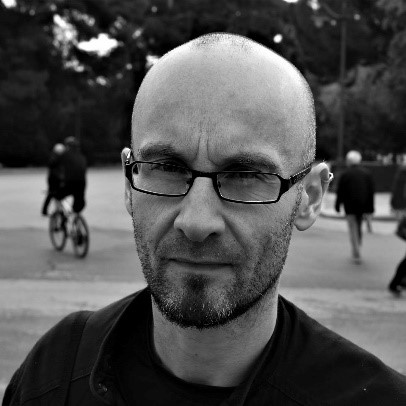
Higgs Centre PhD Coordinator

Deputy Academic Administrator (Graduate School)
Stanford Institute for Theoretical Physics

Our research includes a strong focus on fundamental questions about the new physics underlying the Standard Models of particle physics, cosmology, and gravity; and the nature and applications of our basic frameworks (quantum field theory and string theory) for attacking these questions. Our research also includes a major emphasis on the novel phenomena in condensed matter physics that emerge in systems with many degrees of freedom.
News Spotlight
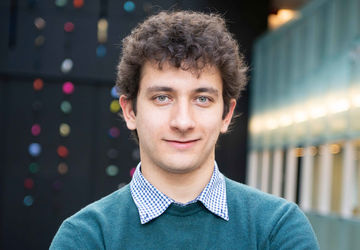
Davide Racco Announced as 2023 Buchalter Cosmology Prize Winner
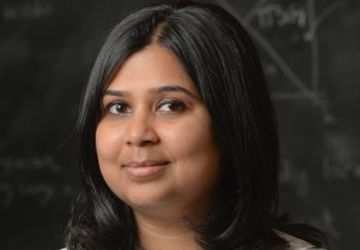
Physicists Observe ‘Unobservable’ Quantum Phase Transition
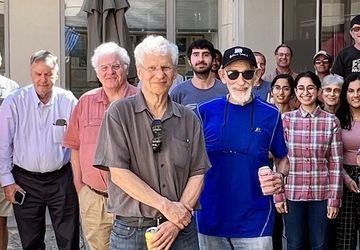
Photo by Zhenhua Wang
Stephen Shenker and Leonard Susskind Awarded 2023 Dirac Medal
Upcoming events.

Applied Physics/Physics Colloquium: Ashvin Vishwanath - The surprising effectiveness of topology in the science of quantum materials
It is a remarkable fact that in recent years topological concepts have played an increasingly prominent role in quantum…

- Friday Phenomenology Group Seminars
Primordial black holes as dark matter
Black holes formed in the early universe can make up all or part of dark matter. I will review some scenarios for their formation,…

Applied Physics/Physics Colloquium: Long Ju - "Emergent Phenomena in Crystalline Multilayer Graphene"
Condensed matter physics has witnessed emergent quantum phenomena driven by electron correlation and topology. Such…
Quick Links
Seminar Schedule News Faculty Postdocs Students Staff Contact Us
- Diversity & Inclusion
- Community Values
- Visiting MIT Physics
- People Directory
- Faculty Awards
- History of MIT Physics
- Policies and Procedures
- Departmental Committees
- Academic Programs Team
- Finance Team
- Meet the Academic Programs Team
- Prospective Students
- Requirements
- Employment Opportunities
- Research Opportunities
- Graduate Admissions
- Doctoral Guidelines
- Financial Support
- Graduate Student Resources
PhD in Physics, Statistics, and Data Science
- MIT LEAPS Program
- for Undergraduate Students
- for Graduate Students
- Mentoring Programs Info for Faculty
- Non-degree Programs
- Student Awards & Honors
- Astrophysics Observation, Instrumentation, and Experiment
- Astrophysics Theory
- Atomic Physics
- Condensed Matter Experiment
- Condensed Matter Theory
- High Energy and Particle Theory
- Nuclear Physics Experiment
- Particle Physics Experiment
- Quantum Gravity and Field Theory
- Quantum Information Science
- Strong Interactions and Nuclear Theory
- Center for Theoretical Physics
- Affiliated Labs & Centers
- Program Founder
- Competition
- Donor Profiles
- Patrons of Physics Fellows Society
- Giving Opportunties
- physics@mit Journal: Fall 2023 Edition
- Events Calendar
- Physics Colloquia
- Search for: Search
Many PhD students in the MIT Physics Department incorporate probability, statistics, computation, and data analysis into their research. These techniques are becoming increasingly important for both experimental and theoretical Physics research, with ever-growing datasets, more sophisticated physics simulations, and the development of cutting-edge machine learning tools. The Interdisciplinary Doctoral Program in Statistics (IDPS) is designed to provide students with the highest level of competency in 21st century statistics, enabling doctoral students across MIT to better integrate computation and data analysis into their PhD thesis research.
Admission to this program is restricted to students currently enrolled in the Physics doctoral program or another participating MIT doctoral program. In addition to satisfying all of the requirements of the Physics PhD, students take one subject each in probability, statistics, computation and statistics, and data analysis, as well as the Doctoral Seminar in Statistics, and they write a dissertation in Physics utilizing statistical methods. Graduates of the program will receive their doctoral degree in the field of “Physics, Statistics, and Data Science.”
Doctoral students in Physics may submit an Interdisciplinary PhD in Statistics Form between the end of their second semester and penultimate semester in their Physics program. The application must include an endorsement from the student’s advisor, an up-to-date CV, current transcript, and a 1-2 page statement of interest in Statistics and Data Science.
The statement of interest can be based on the student’s thesis proposal for the Physics Department, but it must demonstrate that statistical methods will be used in a substantial way in the proposed research. In their statement, applicants are encouraged to explain how specific statistical techniques would be applied in their research. Applicants should further highlight ways that their proposed research might advance the use of statistics and data science, both in their physics subfield and potentially in other disciplines. If the work is part of a larger collaborative effort, the applicant should focus on their personal contributions.
For access to the selection form or for further information, please contact the IDSS Academic Office at [email protected] .
Required Courses
Courses in this list that satisfy the Physics PhD degree requirements can count for both programs. Other similar or more advanced courses can count towards the “Computation & Statistics” and “Data Analysis” requirements, with permission from the program co-chairs. The IDS.190 requirement may be satisfied instead by IDS.955 Practical Experience in Data, Systems, and Society, if that experience exposes the student to a diverse set of topics in statistics and data science. Making this substitution requires permission from the program co-chairs prior to doing the practical experience.
- IDS.190 – Doctoral Seminar in Statistics and Data Science ( may be substituted by IDS.955 Practical Experience in Data, Systems and Society )
- 6.7700[J] Fundamentals of Probability or
- 18.675 – Theory of Probability
- 18.655 – Mathematical Statistics or
- 18.6501 – Fundamentals of Statistics or
- IDS.160[J] – Mathematical Statistics: A Non-Asymptotic Approach
- 6.C01/6.C51 – Modeling with Machine Learning: From Algorithms to Applications or
- 6.7810 Algorithms for Inference or
- 6.8610 (6.864) Advanced Natural Language Processing or
- 6.7900 (6.867) Machine Learning or
- 6.8710 (6.874) Computational Systems Biology: Deep Learning in the Life Sciences or
- 9.520[J] – Statistical Learning Theory and Applications or
- 16.940 – Numerical Methods for Stochastic Modeling and Inference or
- 18.337 – Numerical Computing and Interactive Software
- 8.316 – Data Science in Physics or
- 6.8300 (6.869) Advances in Computer Vision or
- 8.334 – Statistical Mechanics II or
- 8.371[J] – Quantum Information Science or
- 8.591[J] – Systems Biology or
- 8.592[J] – Statistical Physics in Biology or
- 8.942 – Cosmology or
- 9.583 – Functional MRI: Data Acquisition and Analysis or
- 16.456[J] – Biomedical Signal and Image Processing or
- 18.367 – Waves and Imaging or
- IDS.131[J] – Statistics, Computation, and Applications
Grade Policy
C, D, F, and O grades are unacceptable. Students should not earn more B grades than A grades, reflected by a PhysSDS GPA of ≥ 4.5. Students may be required to retake subjects graded B or lower, although generally one B grade will be tolerated.
Unless approved by the PhysSDS co-chairs, a minimum grade of B+ is required in all 12 unit courses, except IDS.190 (3 units) which requires a P grade.
Though not required, it is strongly encouraged for a member of the MIT Statistics and Data Science Center (SDSC) to serve on a student’s doctoral committee. This could be an SDSC member from the Physics department or from another field relevant to the proposed thesis research.
Thesis Proposal
All students must submit a thesis proposal using the standard Physics format. Dissertation research must involve the utilization of statistical methods in a substantial way.
PhysSDS Committee
- Jesse Thaler (co-chair)
- Mike Williams (co-chair)
- Isaac Chuang
- Janet Conrad
- William Detmold
- Philip Harris
- Jacqueline Hewitt
- Kiyoshi Masui
- Leonid Mirny
- Christoph Paus
- Phiala Shanahan
- Marin Soljačić
- Washington Taylor
- Max Tegmark
Can I satisfy the requirements with courses taken at Harvard?
Harvard CompSci 181 will count as the equivalent of MIT’s 6.867. For the status of other courses, please contact the program co-chairs.
Can a course count both for the Physics degree requirements and the PhysSDS requirements?
Yes, this is possible, as long as the courses are already on the approved list of requirements. E.g. 8.592 can count as a breadth requirement for a NUPAX student as well as a Data Analysis requirement for the PhysSDS degree.
If I have previous experience in Probability and/or Statistics, can I test out of these requirements?
These courses are required by all of the IDPS degrees. They are meant to ensure that all students obtaining an IDPS degree share the same solid grounding in these fundamentals, and to help build a community of IDPS students across the various disciplines. Only in exceptional cases might it be possible to substitute more advanced courses in these areas.
Can I substitute a similar or more advanced course for the PhysSDS requirements?
Yes, this is possible for the “computation and statistics” and “data analysis” requirements, with permission of program co-chairs. Substitutions for the “probability” and “statistics” requirements will only be granted in exceptional cases.
For Spring 2021, the following course has been approved as a substitution for the “computation and statistics” requirement: 18.408 (Theoretical Foundations for Deep Learning) .
The following course has been approved as a substitution for the “data analysis” requirement: 6.481 (Introduction to Statistical Data Analysis) .
Can I apply for the PhysSDS degree in my last semester at MIT?
No, you must apply no later than your penultimate semester.
What does it mean to use statistical methods in a “substantial way” in one’s thesis?
The ideal case is that one’s thesis advances statistics research independent of the Physics applications. Advancing the use of statistical methods in one’s subfield of Physics would also qualify. Applying well-established statistical methods in one’s thesis could qualify, if the application is central to the Physics result. In all cases, we expect the student to demonstrate mastery of statistics and data science.
- UFR Droit Economie Management
- UFR Médecine
- UFR Pharmacie
- UFR Sciences
- UFR Sciences du Sport
- AgroParisTech
- CentraleSupélec
- ENS Paris-Saclay
- Institut d'Optique
- Polytech Université Paris-Saclay
- Accessibility

PhD PROGRAM PHYSICS - GRADUATE SCHOOL PHYSICS
The program involves all the PhDs related to the Physics Graduate School. It covers all fields of physics, from fundamental to applied, from theory, modeling and simulation to instrumentation, from laboratory experiments to large instruments placed on large research infrastructures or in space, from the disciplinary core to interfaces.
It also integrates numerous socio-economic issues at the interface with physics (energy, health, environment, etc.).
This program is linked with 4 Doctoral Schools:
- EDOM (Waves and Matter Doctoral School),
- PHENIICS (Particles, Hadrons, Energy, Nuclei, Instrumentation, Imaging, Cosmos and Simulation),
- AAIF (Astronomy and Astrophysics for Paris Area),
- EDPIF (Doctoral School for Physics in Île-de-France)
Physics (all fields)
Program content.
Waves and Matter Doctoral School (EDOM)
The Doctoral School Waves and Matter - EDOM - covers quantum physics, dilute matter and optics.
More precisely, the fields covered are quantum physics, optics, atomic and molecular physics, laser physics, plasma physics, nanophotonics as well as the interface fields of these themes such as biomedical imaging or condensed matter. All types of plasmas are represented at EDOM (cold and hot plasmas, stellar, interstellar and fusion), as well as their technological applications. In particular, EDOM is involved in magnetic confinement fusion.
Learn more about EDOM
Particles, Hadrons, Energy, Nuclei, Instrumentation, Imaging, Cosmos et Simulation (PHENIICS)
The PHENIICS graduate school (ED N° 576) is the Ile-de-France graduate school whose themes are centered on subatomic physics; its particularity is to federate students ranging from applied physics to fundamental physics in this field. It relies on a unique network of research units on this theme, located in the Paris-Saclay area.
Learn more about PHENIICS
Astronomy and Astrophysics for Paris Area(AAIF)
The "Astronomy and Astrophysics of Ile-de-France" Doctoral School offers graduates from physics and mathematics studies training in and through research in the vast interdisciplinary field of astronomy and all its techniques of observation, measurement and calculation.
The Doctoral School offers physicists and mathematicians training in and through research in the vast interdisciplinary field of astronomy and all its methods of observation, measurement and calculation. It covers a field whose development is considerable and unceasing: discovery of extrasolar planets, renewal of cosmology at the interface with particle physics, development of astrochemistry, in situ exploration of the solar system, space navigation, planetology at the interface with the sciences of planet Earth. Powerful observation tools are being prepared, both in space and on the ground, affirming the place of Europe, using a wide variety of advanced technologies (optics, metrology, cryogenics, automation, etc.).
Learn more about AAIF
Physics in Ile de France(EDPIF)
Its scientific field covers essentially the physics of fundamental interactions, the quantum physics of diluted or condensed matter, statistical physics, the physics of soft or biological matter, but also the fundamental aspects of optics, acoustics and hydrodynamics.
Its scientific position is that of fundamental physics, both theoretical and experimental, and the applications that naturally follow from it.
Learn more about EDPIF
- Laboratoire de physique des deux infinis Irène Joliot-Curie (IJCLab, UMR 9012)
- Institut d'astrophysique spatiale (IAS, UMR 8617)
- Unité de recherche SOLEIL (SOLEIL, UR 1)
- Signalisation, radiobiologie et cancer (SCR, UMR 3347)
- Département de Physique des Particules (DRF/IRFU, DPhP)
- Département de Physique Nucléaire (DRF/IRFU, DPhN)
- Département d'Electronique des Détecteurs et d'Informatique pour la Physique (DRF/IRFU, DEDIP)
- Département des Accélérateurs, de la Cryogénie et du Magnétisme (DRF/IRFU, DACM)
- Institut LIST (LIST)
- Département des Matériaux pour le Nucléaire (DES/ISAS, DMN)
- Laboratoire en Informatique Haute Performance pour le Calcul et la simulation (DAM, LIHPC)
- Laboratoire Matière sous conditions extrêmes (DAM, LMCE)
External laboratories :
- Institut de Radioprotection et de sûreté nucléaire : IRSN
- CEA Cadarache/IRESNE/DES/DER/SPRC/LPN
- CEA Marcoule : DES/ISEC/DMRC/SASP/LAAT
- Laboratoire Charles Fabry (LCF, UMR 8501)
- Institut des Sciences Moléculaires d'Orsay (ISMO, UMR 8214)
- Laboratoire de Physique des Solides (LPS, UMR 8502)
- Laboratoire de physique des gaz et des plasmas (LPGP, UMR 8578)
- Laboratoire Matière sous conditions extrêmes (LMCE)
- Optique et techniques associées (DOTA)
- Service de Physique de l'Etat Condensé (SPEC)
- Laboratoire Interactions, Dynamiques et Lasers (LIDYL)
- Centre de Nanosciences et de Nanotechnologies (C2N, UMR 9001)
- Laboratoire de Physique des Plasmas (LPP, UMR 7648)
- Physique, Instrumentation, Environnement, Espace (DPHY)
- Institut de Chimie Physique (ICP, UMR 8000)
- Laboratoire Aimé Cotton (LAC, FRE 2038)
- Laboratoire Lumière, Matière et Interfaces (LuMin, FRE 2036)
- Laboratoire de physique théorique et modèles statistiques (LPTMS, UMR 8626)
- Institut de physique théorique (DRF, IPhT)
- Service de Physique de l'Etat Condensé (DRF/IRAMIS, SPEC)
- Unité mixte de physique CNRS/Thales (UMPhy, UMR 137)
- Institut des Sciences Moléculaires d'Orsay (ISMO, UMR 8214)·
- Unité de recherche SOLEIL (UR 1)
- Service de Recherches de Métallurgie Physique (DES/ISAS/DMN, SRMP)
- Laboratoire Léon Brillouin (DRF/IRAMIS, LLB)
- Fluides, Automatique et Systèmes Thermiques (FAST, UMR 7608)
- Laboratoire de recherche en informatique (LRI, UMR 8623)
- Laboratoire des Signaux et Systèmes (L2S, UMR 8506)
- Maison de la Simulation - DRF (MdlS)
- UMS IOGS-CNRS (UMS 3676)
- Astrophysique, Instrumentation et Modélisation de Paris-Saclay (DRF/IRFU/DAp, AIM)
- Département d'Astrophysique (DRF/IRFU, DAp)
- Laboratoire ATMosphères, Observations Spatiales (LATMOS, UMR 8190)
PhD students admitted to the Phd program will have a public law doctoral contract. The duration of the contract is 3 years. The contractual Phd students are full-time employees with the sole or main mission of carrying out their doctoral project. They may also be entrusted with complementary missions of teaching, scientific mediation, valorization or expertise.
More information
Possible employers* for PhD students under contract to the program are :
- Université Paris-Saclay (Faculties of Sciences of Orsay, Medicine, Pharmacy, Sports Sciences and Law-Economy-Management)
- University of Versailles Saint Quentin en Yvelines
- University of Evry Val d'Essonne
- Centrale Supélec
* This list remains to be completed or specified
The Doctoral Schools of the GS Physics PhD program supervise the PhD students throughout their thesis, by appointing referents who interact with them regularly.
EDOM : During the course of their thesis, PhD students have access to an individual monitoring committee, an advisory body that ensures, through annual meetings with the student, that their doctoral training is going well. This committee monitors the progress of the PhD student in his/her ability to present his/her research work. It helps the PhD student to take stock of the progress of his or her doctoral training, as well as the state of preparation for his or her future career.
AAIF : The AAIF doctoral school organizes a post-thesis training during which PhD students can meet the presidents of the A&A sections of the CNRS, CNU and CNAP, meet company managers from the aerospace sector, and work on writing CVs and application letters under the supervision of recruitment professionals. In 2021, the AAIF ED has also established a partnership with PhDTalent to promote the skills of these PhD students on social networks (LinkedIn, Twitter), to post job offers selected from keywords adapted to their skills and expertise.
- EDPIF : For each PhD student, an individual monitoring committee is set up, independent of the thesis director. A meeting concerning the progress of the thesis and the future is organized with the monitoring committee, the PhD student and the supervisors at the end of each year of the thesis (at least). During this meeting, the monitoring committee must also discuss with the supervisor(s) in the absence of the PhD student and conversely with the PhD student without the supervisor(s). At the end of this meeting, the follow-up committee sends its report on the meeting to the ED and possibly makes recommendations on the continuation of the thesis and on re-registration. Additional meetings of the follow-up committee are organized for any thesis presenting specific problems, whatever their nature, or extending, as an exception, over all or part of a fourth year. For more details see : https://www.edpif.org/fr/parcours/suivi.php
- PHENIICS : Each PhD student is supervised by a person who follows him/her throughout the thesis. The progress of the thesis work and the training courses followed are reviewed each year at the time of registration. A sponsorship system is also in place in most laboratories. In case of problems revealed either during the annual interview or during the course of the thesis thanks to the sponsorship system, a supervisory committee is set up to understand the nature of the problems and to propose solutions.
PhD students enrolled in the Doctoral Schools of the GS Physics program find employment in both the academic and private sectors.
Approximately half of our PhDs eventually find a job in the field of research in universities or large research organizations in France (CNRS, CEA, ONERA, etc...) or abroad. Industry is also a very important outlet. Most of our PhDs work in technical or technological fields that allow them to make the most of the skills they have acquired. They are divided between large groups (Thales, Saint Gobain, etc.), SMEs and technological start-ups.
Over a 10-year period, about 30% of PhDs enter the world of academic research in France or abroad. Some go on to secondary education. Most pursue a career in the private sector with a very wide range of scientific and management professions in France or abroad. The number of unemployed PhDs is around 3%.
While the historical career outlet of the PhD is higher education and research, a significant and growing number of PhDs are pursuing their careers in the private sector, in many types of functions, and not only in R&D. According to the statistical study conducted in 2017 by the MESR on PhDs who graduated in 2015, 46% of PhDs in physics have a job in the academic sector and exactly as many in the private sector, of which only 20% are in R&D. For more details see : https://www.edpif.org/fr/parcours/poursuite.php
More than half of the PhDs are employed in the academic world in France (universities and research organizations) or abroad. Many PhDs also join the R&D departments of large technology-based groups (Thales, Safran, Areva, EDF, etc.), while others find employment in small and medium-sized companies with high industrial and technological value or in start-ups, of which they may also be founders.
How to be admitted to the doctoral program in Physics ?
Find below the different steps to apply to the Physics Program - Graduate School Physics
Prerequisite
The student must hold a Master's degree (or equivalent) and have the agreement of the thesis director.
Evaluation criteria
The main evaluation criteria are the quality of the candidate's academic record, the quality of his/her presentation and his/her answers to questions during the audition, as well as the relevance of the candidate's background in relation to the thesis topic and the host team.
Other relevant evaluation criteria are :
- the results obtained by the candidate in the Master's program (M1 and M2) ;
- the candidate's research skills, as assessed from the research internship periods;
- letters of recommendation;
- the candidate's motivation and ability to integrate into the research team;
- the professional project expressed by the candidate and its consistency with the doctoral project.
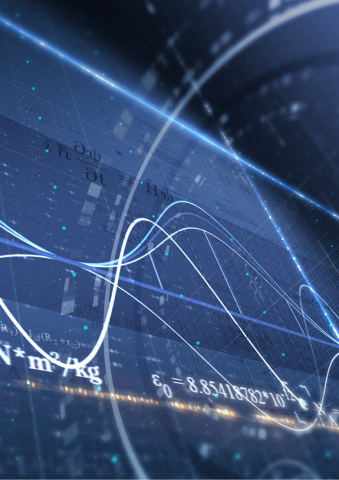
Where and how to apply?
Have you found your subject?
Identify the doctoral school related to your subject
Consult below the application procedures of the doctoral school concerned
Submit your application on ADUM
How to apply to ED EDOM?
Application file format, audition format, jury – examination of the application, 2024 calendar - candidates.
- All mandatory sections of ADUM,
- A one or two page Curriculum Vitae,
- An opinion from two former research internship supervisors according to a specific form,
- One or two letters of recommendation,
- Transcripts from the last year of the Bachelor's degree (or equivalent),
- Transcripts from the different years of the Master's program (or equivalent),
- A copy of the Master's degree or certificate of completion if available,
- A copy of an identity card.
The audition lasts 25 minutes in total.
The candidate has 12 minutes for his/her presentation.
The remaining time is dedicated to questions from the jury. Format The recommended format for the presentation is as follows
- 1 sheet of CV,
- 3-4 sheets presenting a research internship,
- 2 sheets presenting the thesis project.
During the questions, the main focus is on the research internship presented by the candidate. The audition can be done by videoconference. The future thesis director is invited to the audition as an observer.
The eligibility jury (examination of the files) is made up of the EDOM office (director and assistant director).
The audition jury is made up of members of the doctoral school's board. It meets in the form of 2 sub-juries. No member of the jury auditions a candidate from his/her own laboratory.
- Tuesday April 9, 2024: Deadline for submission of thesis topics on ADUM
- Tuesday April 23, 2024: Closing date for applications on ADUM
- Monday June 3 and Tuesday June 4, 2024: Audition of candidates
- Monday June 10, 2024: Announcement of results
How to apply to ED PHENIICS?
Jury - examination of the application, 204 calendar - candidates.
All sections of ADUM.
If applicable, the most recent MASTER grades or transcripts
Exchange of about 20 minutes with the jury, no slide presentation is required.
The candidate first briefly explains his or her doctoral project (Why this thesis? What is the interest? What is the context? etc...)
then the discussion continues in the form of questions and answers.
The jury is made up of members of the board of directors, supplemented by members of the council in order to ensure the thematic coverage of the competition.
The elected representatives of the PhD students on the board are invited as observers.
The ranking is established by the jury after the auditions.
- Friday April 26, 2024: Deadline for submission of thesis topics on ADUM
- Friday May 10, 2024: Application deadline on ADUM
- Wednesday May 29 to Friday May 31, 2024: Audition of candidates
How to apply to ED AAIF?
2024 calendar - candidates.
All sections of ADUM.
A transcript of grades from a MASTER's degree or recent equivalent.
The audition lasts 20 minutes.
A 10-minute presentation should outline the candidate's previous research experiences (their scientific objectives, methodologies used and results obtained) and should show that the candidate understands the issues at stake in the proposed topic and how he or she is capable of making a significant contribution to it.
The candidate may spend 1 to 2 minutes introducing him/herself, 4-5 minutes describing his/her research experience (mainly the M2 internship) and 4-5 minutes on the thesis topic and its issues.
This presentation is followed by 10 minutes of questions.
The admissibility jury (examination of the files) is made up of the ED office (director and deputy director).
The audition jury is made up of members of the doctoral school's board.
A first jury of the competition (beginning of June) reviews the applications, and is likely to attribute at most 1/3 of the available doctoral contracts. The selected candidates are notified directly by e-mail.
The final jury of the competition (beginning of July) allocates all the remaining available contracts and creates a waiting list. The selected candidates are asked to respond to this proposal within a week in order to allow a good management of the withdrawals.
- Wednesday January 31, 2024 Thesis submission deadline
- Friday April 19, 2024 Closing date for submission of thesis topics on ADUM
- May 28, 29 and 30 - June 3 and 4, 2024 Audition of candidates
- Friday June 7, 2024 Announcement of results
How to apply to ED PIF?
2024 calendar – candidates.
Applications are made online at : https://www.edpif.org/fr/recrutement/candid.php
Candidates have ten minutes to introduce themselves with particular emphasis on their past research activities.
A maximum (indicative) of two slides should be devoted to the presentation of the thesis topic.
The eligibility jury then asks questions for approximately five minutes.
Candidates may speak in English or French, as they wish.
The competition is managed by a competition committee made up of the four members of the doctoral school's board of directors and four teacher-researchers or researchers from the ED's laboratories, from each of the supporting institutions.
The competition jury is made up of the members of the competition committee, as well as researchers or teacher-researchers designated by the competition committee. The board and the jury, renewed in whole or in part each year, are composed in such a way as to best represent all the themes of the ED.
Their composition is submitted to the ED council.
- The competition office carries out a pre-selection of candidates who will be selected for an audition.
- The selected candidates are then auditioned by the competition jury, divided into 4 sub-juries.
- The competition office finally establishes a ranking consisting of a main list and a supplementary list. This ranking is based on the evaluation of the academic file and on the audition. It takes into account the number of doctoral contracts awarded by each institution.
- Finally, the ED council validates the distribution of funding on the basis of the ranking established by the jury
- November 3, 2023 : Applications open
- Thursday April 25, 2024: Deadline for submission of thesis topics
- Monday April 29, 2024: Closing date for applications on ADUM
- Monday June 3 to Thursday June 6, 2024: Audition of candidates
- From June 8, 2024: Announcement of results
Communication tools
The employment status of graduate school physics phds as of december 1, 2019.
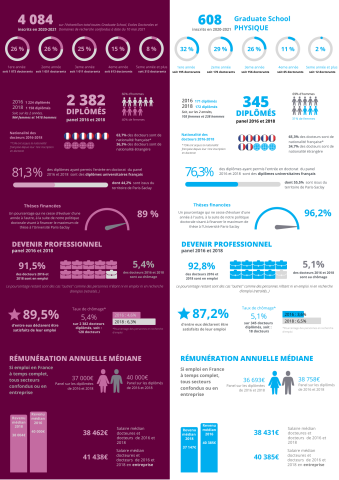

IMAGES
VIDEO
COMMENTS
Theoretical Astrophysics and Cosmology. Calculating and modeling the physics of the cosmos. First objects in the universe, relativistic astrophysics, neutron stars, black holes, inflation, cosmic evolution and structure. Current research in theoretical astrophysics and cosmology at Stanford explores a wide range of critical questions.
Theoretical Astrophysics. Understanding the cosmos involves both observation and theory. Observation provides real-world data about how stars, galaxies, and other objects in space behave. Theory connects that data together into a full understanding, and makes predictions about phenomena we haven't observed yet.
The Department of Astrophysical Sciences offers advanced training in astrophysics. The faculty and staff in the department conduct world-leading research in theoretical and computational astrophysics, observational astronomy, astronomical surveys, and instrumentation (both hardware and software). The fascinating discoveries of modern astronomy ...
The PhD program in astrophysics develops creative scholarship in students and prepares them for professional careers in astrophysics, astronomy or related fields. ... Graduate students work closely with a research advisor on a wide range of topics including theoretical physics, cosmology, galaxy dynamics, stellar evolution, exoplanets, and the ...
The DPhil in Astrophysics is a research-based degree offered by the astrophysics and theoretical physics sub-departments of Physics, available to students interested in carrying out research in observational or theoretical astrophysics, or in astronomical instrumentation. The course has a strong track record of preparing students for careers in ...
The Theoretical Astrophysics (TA) Division at the Center for Astrophysics conducts field-leading research through the synthesis of expertise in theoretical and computational modeling with empirical data from the Center for Astrophysics' observational and experimental divisions. The TA Division is composed of Harvard Astronomy Faculty ...
The Department of Astronomy & Astrophysics is a world leader in astrophysical research and offers rigorous academic programs at both the graduate and undergraduate level. ... Subrahmanyan Chandrasekhar defined the agenda of theoretical astrophysics for fifty years; Eugene Parker revolutionized our view of the sun and the role of magnetic fields ...
Graduate Studies. The Harvard Department of Physics offers students innovative educational and research opportunities with renowned faculty in state-of-the-art facilities, exploring fundamental problems involving physics at all scales. Our primary areas of experimental and theoretical research are atomic and molecular physics, astrophysics and ...
Research is a major part of the PhD program, and the department offers opportunities in a wide variety of fields, including theoretical and observational astrophysics; infrared, optical, and radio astronomy; time-domain astronomy; high-energy astrophysics and cosmology; discovery and analysis of exoplanets; star formation and stellar evolution.
At Caltech we typically graduate between 2 and 6 Astronomy Ph.D.s per year, and a similar number of Physics graduate students whose primary interest is astrophysics. Our matriculating first-year class in Astronomy ranges from year to year between 2 and 9 students. Presently in Astronomy, there are 25 graduate students.
A wide range of research projects—both theoretical and experimental—are available in astrophysics, condensed matter physics, and particle physics. Graduate students can work toward a PhD in either physics or astronomy and astrophysics. Our doctoral students are prepared for careers in physics and astronomy research, teaching, or in ...
Astrophysics Theory. Theorists in the astrophysics division use combinations of calculations, simulations, and observations to characterize and understand astrophysical phenomena on a wide range of scales, ranging from exoplanets, black holes, and neutron stars, to the dynamics of stars and galaxies, all the way to the universe at large.
The Physics PhD program and Physics: Astrophysics PhD Program offer a full range of graduate level courses and research opportunities in astronomy, biophysics, condensed matter physics, cosmology, elementary particle physics, and quantum information. The Tufts Physics faculty have international reputations in a broad range of subjects, and collaborations between department members and members ...
Theory plays an increasingly important role in astronomy to interpret data, predict new phenomena, and inform observing strategies. The Carnegie Theoretical Astrophysics Center (CTAC) brings theorists and observers together at the cutting edge of astrophysical research to better understand the mysteries of the universe. Learn More.
Why Study Astrophysical Sciences at RIT. Unique Interdisciplinary Approach: This multidisciplinary program is administered by the School of Physics and Astronomy, in collaboration with the School of Mathematics and Statistics and the Chester F. Carlson Center for Imaging Science, setting it apart from conventional astrophysics graduate programs at traditional research universities.
Graduate students have opportunities for research in theoretical physics, AMO physics, ultra-fast lasers, particle and nuclear physics, condensed matter physics, quantum information and control, cosmology, astrophysics, and gravitation. ... The Department of Physics welcomes graduate applications from individuals with a broad range of life ...
About the course. The DPhil in Theoretical Physics is a research-based course of three to four years in duration. Students working towards their DPhil in Theoretical Physics can choose from topics ranging from astrophysics and plasma physics to condensed matter theory to particle theory and we collaborate with experimentalists in other sub-departments and worldwide.
PhD Programmes. We run PhD programmes in a variety of subjects. A PhD in Theoretical Physics may be taken in: Astrophysics and Cosmology. Condensed Matter and Complex Systems. Theoretical Particle Physics. Visit our Postgraduate Research page to find out more about PhD projects, funding opportunities, student profiles and how to apply.
Stanford Institute for Theoretical Physics. Our research includes a strong focus on fundamental questions about the new physics underlying the Standard Models of particle physics, cosmology, and gravity; and the nature and applications of our basic frameworks (quantum field theory and string theory) for attacking these questions.
Help is available from the Physics Graduate Admissions Office at [email protected] and additional assistance from current students is offered during the admissions season. Further details are described at the end of this page in our Assistance for Prospective Applicants section. The list below describes the important elements of a complete ...
Many PhD students in the MIT Physics Department incorporate probability, statistics, computation, and data analysis into their research. These techniques are becoming increasingly important for both experimental and theoretical Physics research, with ever-growing datasets, more sophisticated physics simulations, and the development of cutting-edge machine learning tools.
The Centre for Astrophysics and Supercomputing (CAS) at Swinburne University of Technology in Melbourne invites applications from high-calibre students of any nationality for its PhD program. CAS is one of Australia's largest astronomy research institutes, with about 20 faculty, 20 postdoctoral researchers, and 40 PhD students. Swinburne has guaranteed access to the 10-m Keck telescopes, with ...
PhD PROGRAM PHYSICS - GRADUATE SCHOOL PHYSICS. The program involves all the PhDs related to the Physics Graduate School. It covers all fields of physics, from fundamental to applied, from theory, modeling and simulation to instrumentation, from laboratory experiments to large instruments placed on large research infrastructures or in space ...
The Director of the Center for Theoretical Physics PAS invites applications for PhD student fellowship at the CTP PAS, financed from the project MAESTRO 15 "Dy namics of processes around compact stars" funded by National Science Center (grant registration number: UMO - 2023/50/A/ST9/00527). PI of the project is Prof. dr hab. Agnieszka Janiuk. The aim of the project is to study accretion ...